Attached files
| file | filename |
|---|---|
| EX-99.3 - EXHIBIT 99.3 PRO FORMA - Thermon Group Holdings, Inc. | exhibit993unauditedproform.htm |
| EX-23.1 - EXHIBIT 23.1 DELOITTE CONSENT - Thermon Group Holdings, Inc. | consentofindependentaudi.htm |
| 8-K/A - 8-K/A CCI CLOSE - Thermon Group Holdings, Inc. | a8-kacciclose.htm |
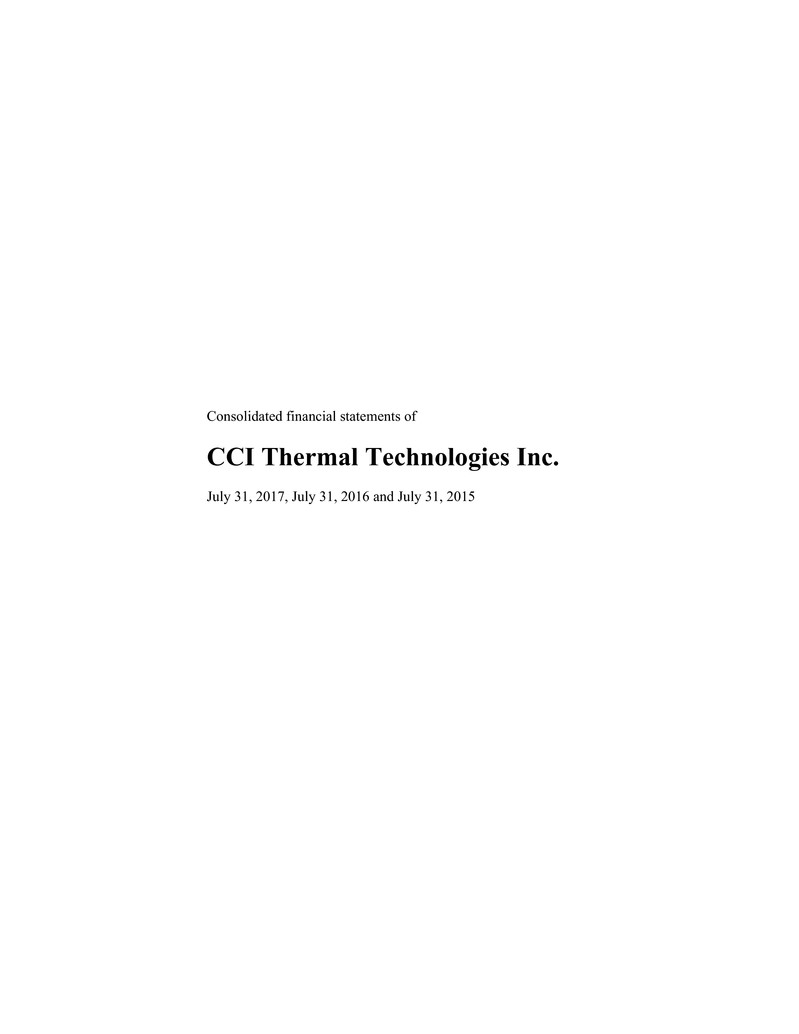
Consolidated financial statements of
CCI Thermal Technologies Inc.
July 31, 2017, July 31, 2016 and July 31, 2015

CCI Thermal Technologies Inc.
July 31, 2017, July 31, 2016 and July 31, 2015
Table of contents
Independent Auditor’s Report ............................................................................................................................ 1-2
Consolidated statements of financial position ....................................................................................................... 3
Consolidated statements of income and comprehensive income ......................................................................... 4
Consolidated statements of changes in shareholders’ equity ............................................................................... 5
Consolidated statements of cash flows ................................................................................................................. 6
Notes to the consolidated financial statements ................................................................................................ 7-27
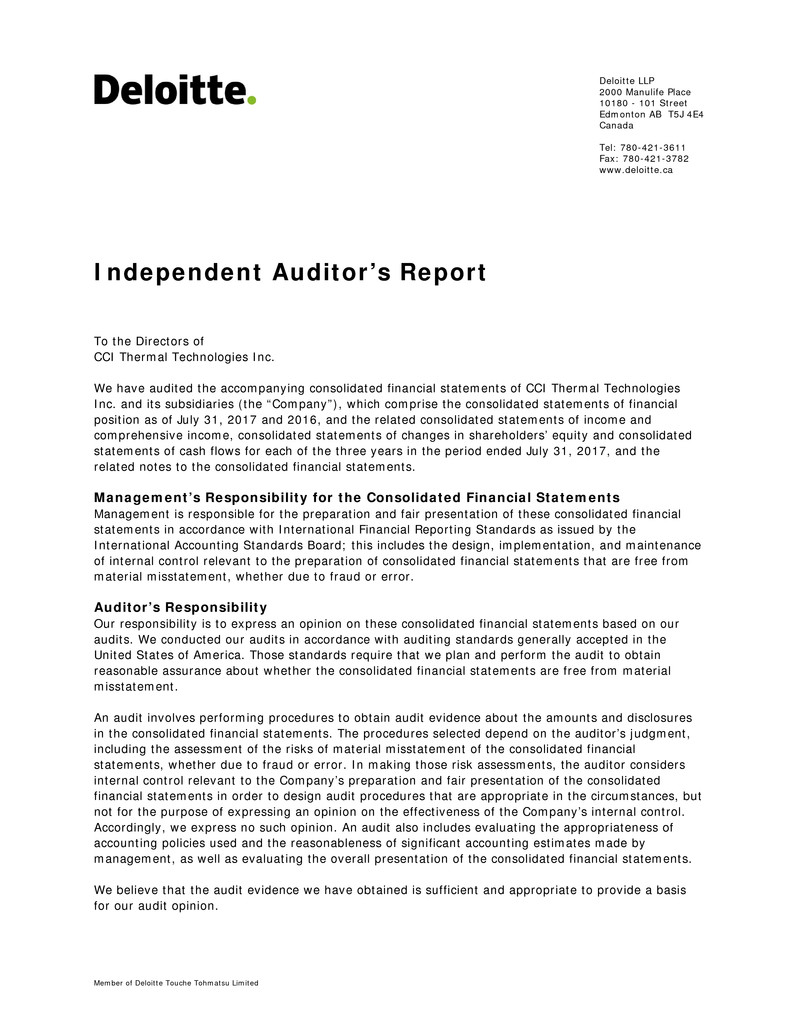
Member of Deloitte Touche Tohmatsu Limited
Deloitte LLP
2000 Manulife Place
10180 - 101 Street
Edmonton AB T5J 4E4
Canada
Tel: 780-421-3611
Fax: 780-421-3782
www.deloitte.ca
Independent Auditor’s Report
To the Directors of
CCI Thermal Technologies Inc.
We have audited the accompanying consolidated financial statements of CCI Thermal Technologies
Inc. and its subsidiaries (the “Company”), which comprise the consolidated statements of financial
position as of July 31, 2017 and 2016, and the related consolidated statements of income and
comprehensive income, consolidated statements of changes in shareholders’ equity and consolidated
statements of cash flows for each of the three years in the period ended July 31, 2017, and the
related notes to the consolidated financial statements.
Management’s Responsibility for the Consolidated Financial Statements
Management is responsible for the preparation and fair presentation of these consolidated financial
statements in accordance with International Financial Reporting Standards as issued by the
International Accounting Standards Board; this includes the design, implementation, and maintenance
of internal control relevant to the preparation of consolidated financial statements that are free from
material misstatement, whether due to fraud or error.
Auditor’s Responsibility
Our responsibility is to express an opinion on these consolidated financial statements based on our
audits. We conducted our audits in accordance with auditing standards generally accepted in the
United States of America. Those standards require that we plan and perform the audit to obtain
reasonable assurance about whether the consolidated financial statements are free from material
misstatement.
An audit involves performing procedures to obtain audit evidence about the amounts and disclosures
in the consolidated financial statements. The procedures selected depend on the auditor’s judgment,
including the assessment of the risks of material misstatement of the consolidated financial
statements, whether due to fraud or error. In making those risk assessments, the auditor considers
internal control relevant to the Company’s preparation and fair presentation of the consolidated
financial statements in order to design audit procedures that are appropriate in the circumstances, but
not for the purpose of expressing an opinion on the effectiveness of the Company’s internal control.
Accordingly, we express no such opinion. An audit also includes evaluating the appropriateness of
accounting policies used and the reasonableness of significant accounting estimates made by
management, as well as evaluating the overall presentation of the consolidated financial statements.
We believe that the audit evidence we have obtained is sufficient and appropriate to provide a basis
for our audit opinion.
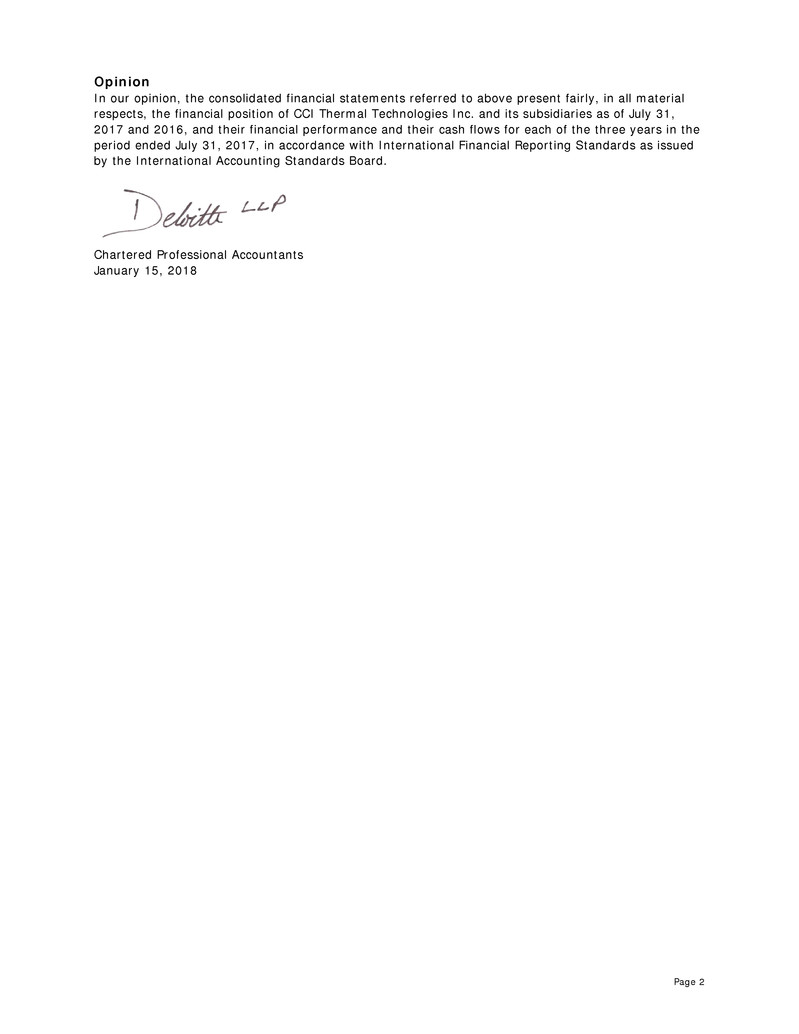
Page 2
Opinion
In our opinion, the consolidated financial statements referred to above present fairly, in all material
respects, the financial position of CCI Thermal Technologies Inc. and its subsidiaries as of July 31,
2017 and 2016, and their financial performance and their cash flows for each of the three years in the
period ended July 31, 2017, in accordance with International Financial Reporting Standards as issued
by the International Accounting Standards Board.
Chartered Professional Accountants
January 15, 2018
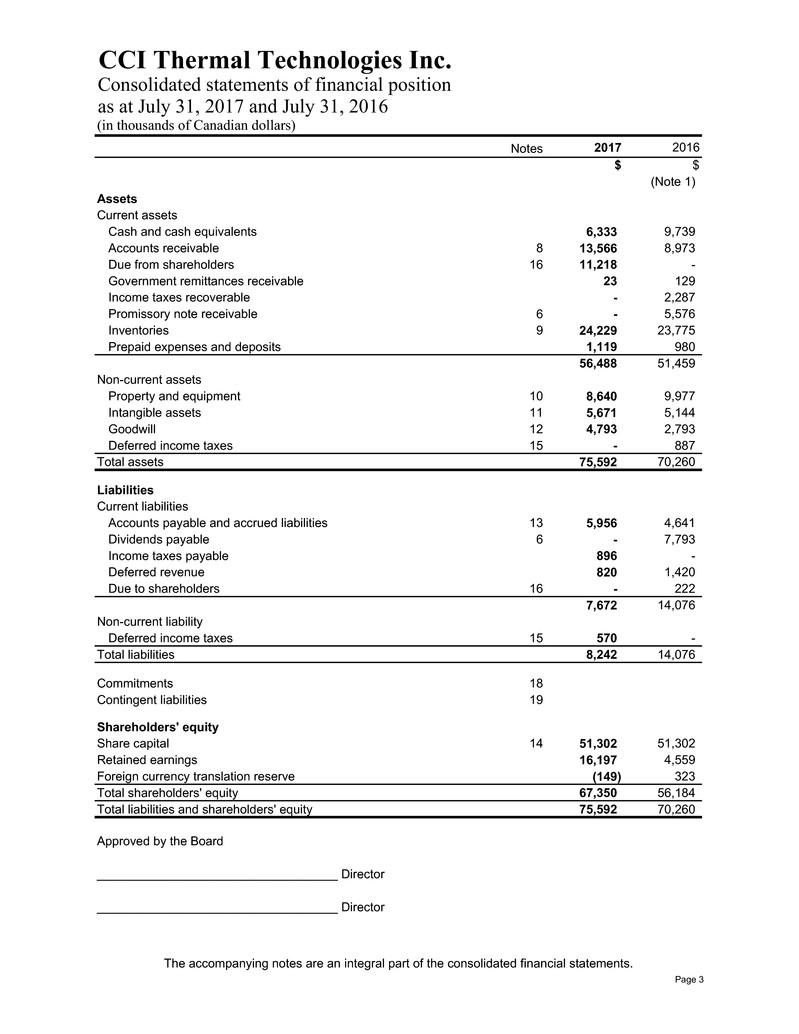
CCI Thermal Technologies Inc.
Consolidated statements of financial position
as at July 31, 2017 and July 31, 2016
(in thousands of Canadian dollars)
Notes 2017 2016
$ $
(Note 1)
Assets
Current assets
Cash and cash equivalents 6,333 9,739
Accounts receivable 8 13,566 8,973
Due from shareholders 16 11,218 -
Government remittances receivable 23 129
Income taxes recoverable - 2,287
Promissory note receivable 6 - 5,576
Inventories 9 24,229 23,775
Prepaid expenses and deposits 1,119 980
56,488 51,459
Non-current assets
Property and equipment 10 8,640 9,977
Intangible assets 11 5,671 5,144
Goodwill 12 4,793 2,793
Deferred income taxes 15 - 887
Total assets 75,592 70,260
Liabilities
Current liabilities
Accounts payable and accrued liabilities 13 5,956 4,641
Dividends payable 6 - 7,793
Income taxes payable 896 -
Deferred revenue 820 1,420
Due to shareholders 16 - 222
7,672 14,076
Non-current liability
Deferred income taxes 15 570 -
Total liabilities 8,242 14,076
Commitments 18
Contingent liabilities 19
Shareholders' equity
Share capital 14 51,302 51,302
Retained earnings 16,197 4,559
Foreign currency translation reserve (149) 323
Total shareholders' equity 67,350 56,184
Total liabilities and shareholders' equity 75,592 70,260
Approved by the Board
___________________________________ Director
___________________________________ Director
The accompanying notes are an integral part of the consolidated financial statements.
Page 3
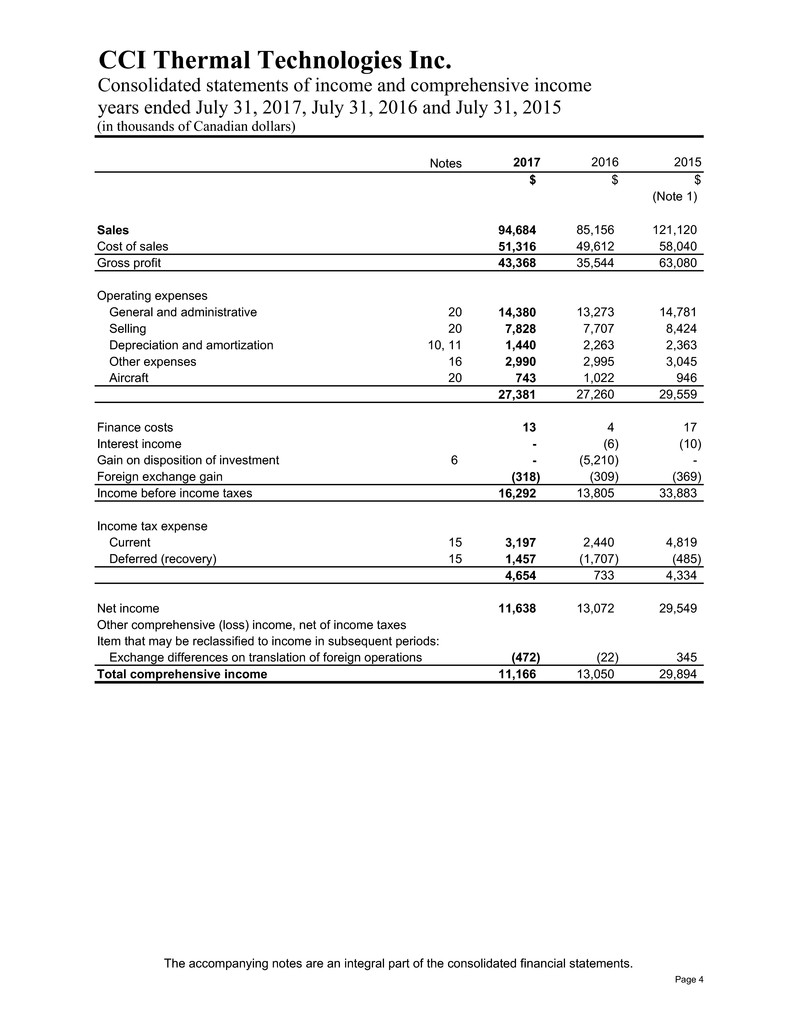
CCI Thermal Technologies Inc.
Consolidated statements of income and comprehensive income
years ended July 31, 2017, July 31, 2016 and July 31, 2015
(in thousands of Canadian dollars)
Notes
2017
2016
2015
$ $ $
(Note 1)
Sales 94,684 85,156 121,120
Cost of sales 51,316 49,612 58,040
Gross profit 43,368 35,544 63,080
Operating expenses
General and administrative 20 14,380 13,273 14,781
Selling 20 7,828 7,707 8,424
Depreciation and amortization 10, 11 1,440 2,263 2,363
Other expenses 16 2,990 2,995 3,045
Aircraft 20 743 1,022 946
27,381 27,260 29,559
Finance costs 13 4 17
Interest income - (6) (10)
Gain on disposition of investment 6 - (5,210) -
Foreign exchange gain (318) (309) (369)
Income before income taxes 16,292 13,805 33,883
Income tax expense
Current 15 3,197 2,440 4,819
Deferred (recovery) 15 1,457 (1,707) (485)
4,654 733 4,334
Net income 11,638 13,072 29,549
Other comprehensive (loss) income, net of income taxes
Item that may be reclassified to income in subsequent periods:
Exchange differences on translation of foreign operations (472) (22) 345
Total comprehensive income 11,166 13,050 29,894
The accompanying notes are an integral part of the consolidated financial statements.
Page 4
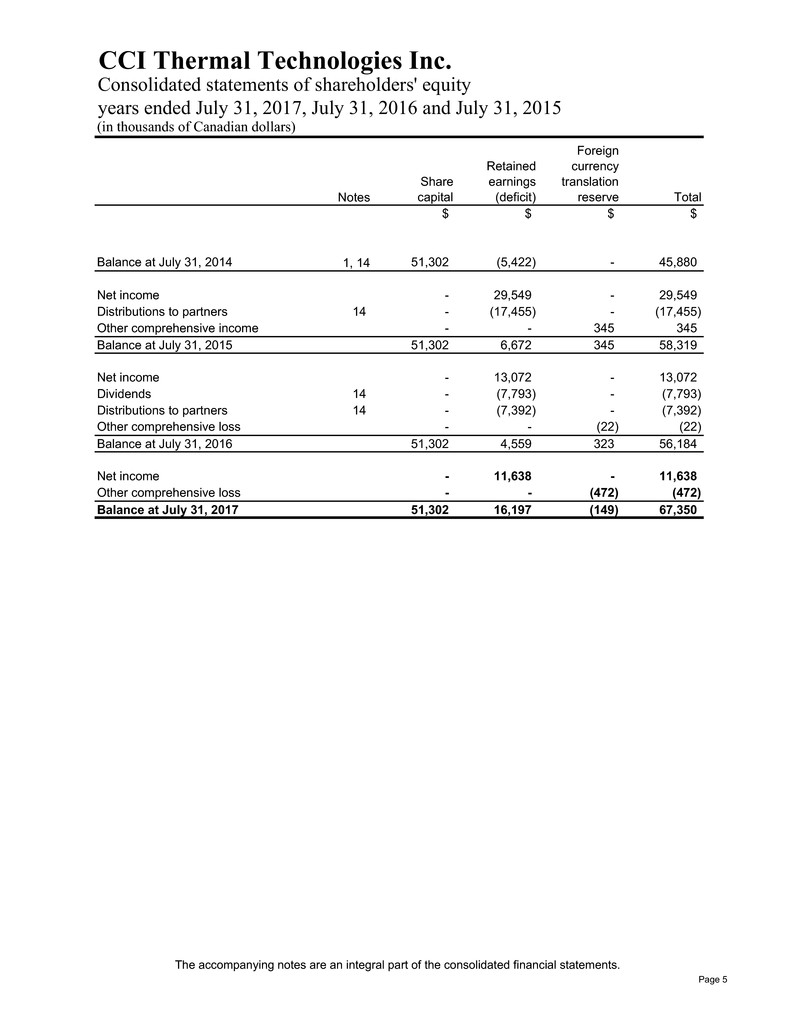
CCI Thermal Technologies Inc.
Consolidated statements of shareholders' equity
years ended July 31, 2017, July 31, 2016 and July 31, 2015
(in thousands of Canadian dollars)
Notes
Share
capital
Retained
earnings
(deficit)
Foreign
currency
translation
reserve Total
$ $ $ $
Balance at July 31, 2014 1, 14 51,302 (5,422) - 45,880
Net income - 29,549 - 29,549
Distributions to partners 14 - (17,455) - (17,455)
Other comprehensive income - - 345 345
Balance at July 31, 2015 51,302 6,672 345 58,319
Net income - 13,072 - 13,072
Dividends 14 - (7,793) - (7,793)
Distributions to partners 14 - (7,392) - (7,392)
Other comprehensive loss - - (22) (22)
Balance at July 31, 2016 51,302 4,559 323 56,184
Net income - 11,638 - 11,638
Other comprehensive loss - - (472) (472)
Balance at July 31, 2017 51,302 16,197 (149) 67,350
The accompanying notes are an integral part of the consolidated financial statements.
Page 5
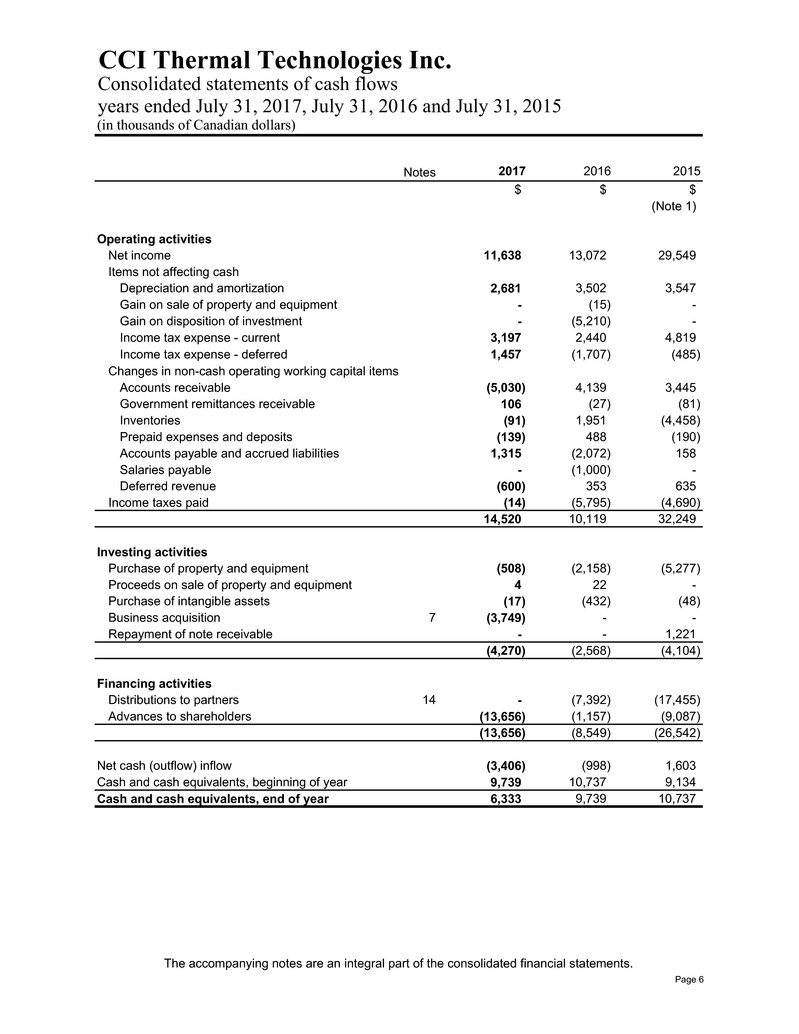
CCI Thermal Technologies Inc.
Consolidated statements of cash flows
years ended July 31, 2017, July 31, 2016 and July 31, 2015
(in thousands of Canadian dollars)
Notes 2017 2016 2015
$ $ $
(Note 1)
Operating activities
Net income 11,638 13,072 29,549
Items not affecting cash
Depreciation and amortization 2,681 3,502 3,547
Gain on sale of property and equipment - (15) -
Gain on disposition of investment - (5,210) -
Income tax expense - current 3,197 2,440 4,819
Income tax expense - deferred 1,457 (1,707) (485)
Changes in non-cash operating working capital items
Accounts receivable (5,030) 4,139 3,445
Government remittances receivable 106 (27) (81)
Inventories (91) 1,951 (4,458)
Prepaid expenses and deposits (139) 488 (190)
Accounts payable and accrued liabilities 1,315 (2,072) 158
Salaries payable - (1,000) -
Deferred revenue (600) 353 635
Income taxes paid (14) (5,795) (4,690)
14,520 10,119 32,249
Investing activities
Purchase of property and equipment (508) (2,158) (5,277)
Proceeds on sale of property and equipment 4 22 -
Purchase of intangible assets (17) (432) (48)
Business acquisition 7 (3,749) - -
Repayment of note receivable - - 1,221
(4,270) (2,568) (4,104)
Financing activities
Distributions to partners 14 - (7,392) (17,455)
Advances to shareholders (13,656) (1,157) (9,087)
(13,656) (8,549) (26,542)
Net cash (outflow) inflow (3,406) (998) 1,603
Cash and cash equivalents, beginning of year 9,739 10,737 9,134
Cash and cash equivalents, end of year 6,333 9,739 10,737
The accompanying notes are an integral part of the consolidated financial statements.
Page 6

CCI Thermal Technologies Inc.
Notes to the consolidated financial statements
July 31, 2017, July 31, 2016 and July 31, 2015
(in thousands of Canadian dollars)
Page 7
1. Description of business and reorganization
CCI Thermal Technologies Inc. (the “Company”) was incorporated on November 19, 1991 under the
Alberta Business Corporations Act and is primarily engaged in investing.
The address of the Company’s registered office and principal place of business is 5918 Roper Rd NW,
Edmonton, Alberta, Canada T6B 3E1.
The Company was the general partner of CCI Thermal Technologies Partnership (the “Partnership”), up
to and including July 31, 2016. Effective August 1, 2016, the Company and the Partnership completed a
reorganization whereby the limited partners of the Partnership, CCI Thermal Technologies
Employees Inc. (“Employees”) and Camary Holdings Ltd. (“Camary”), each exchanged their interest in
the Partnership for an equivalent interest in the Company, on a tax deferred basis under Section 85 of
the Income Tax Act (Canada). As a result, the Partnership was dissolved and the net assets and
business of the Partnership were transferred to the Company. Employees and Camary exchanged their
interests in the Partnership for common shares of the Company. Refer to Note 14 for details on the
reorganization transaction.
Prior to August 1, 2016, the Company was wholly owned by Rocor Holdings Ltd. (“Rocor”). Subsequent
to August 1, 2016, Employees, Camary and Rocor own 150 Class A common shares, 425 Class A
common shares and 425 Class A common shares of the Company, respectively.
Management has determined that IFRS 3, Business Combinations, does not apply as the reorganization
transaction is considered a common control transaction whereby the entities included in the
reorganization (i.e. the Company and the Partnership) are ultimately controlled by the same parties
before and after the reorganization and there has been no substantive change in ownership. Instead,
management has applied the continuity of business method whereby the assets and liabilities of the
entities included in the reorganization are recorded at their existing carrying values rather than fair value,
no goodwill is recorded and the comparative periods have been restated (except for number of shares)
as if the reorganization had taken place at the beginning of the earliest comparative period presented.
The Company and its subsidiaries are primarily engaged in engineering and manufacturing a wide array
of heating and filtration products for industrial and hazardous area applications.
2. Basis of preparation and statement of compliance
a) Statement of compliance
These consolidated financial statements have been prepared in accordance with International
Financial Reporting Standards (“IFRS”), and the accounting policies set out below have been
applied consistently to all periods presented. These consolidated financial statements comply with
IFRS as issued by the International Accounting Standards Board (“IASB”).
These consolidated financial statements were approved by the Board of Directors (the “Directors”)
on January 15, 2018.
b) Basis of measurement
The Company’s consolidated financial statements have been prepared on a going concern basis,
under the historical cost model, except for certain financial instruments measured at fair value.
c) Functional and presentation currency
These consolidated financial statements are presented in Canadian dollars, which is the Company’s
functional and presentation currency.
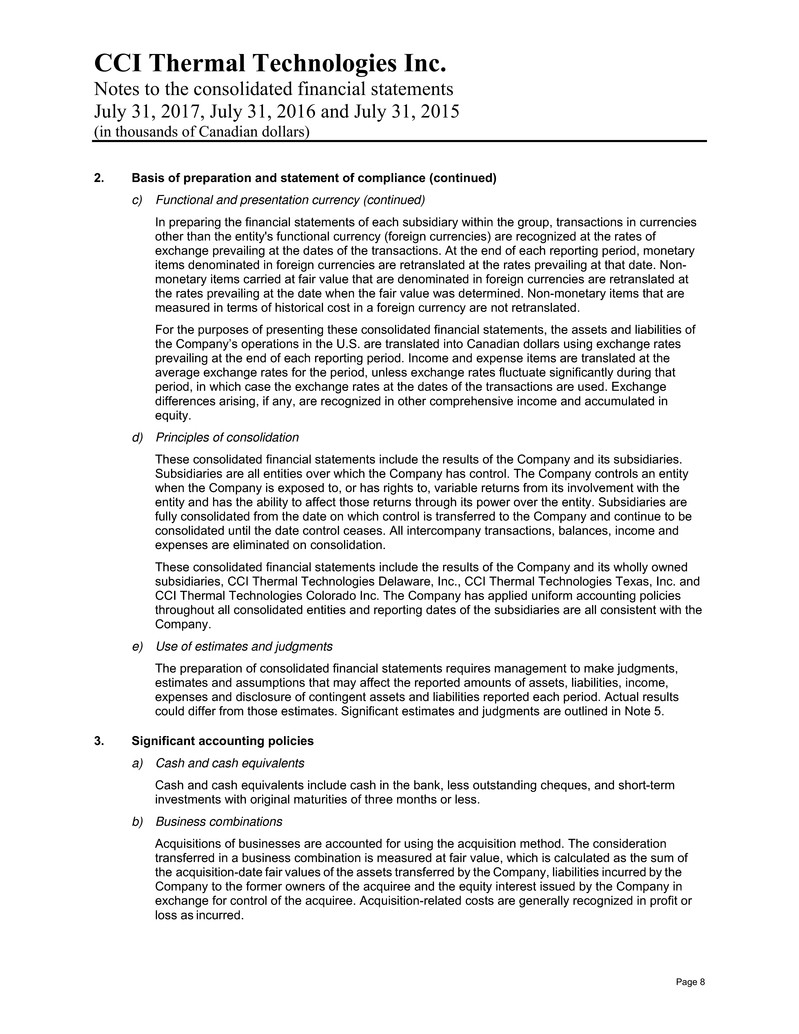
CCI Thermal Technologies Inc.
Notes to the consolidated financial statements
July 31, 2017, July 31, 2016 and July 31, 2015
(in thousands of Canadian dollars)
Page 8
2. Basis of preparation and statement of compliance (continued)
c) Functional and presentation currency (continued)
In preparing the financial statements of each subsidiary within the group, transactions in currencies
other than the entity's functional currency (foreign currencies) are recognized at the rates of
exchange prevailing at the dates of the transactions. At the end of each reporting period, monetary
items denominated in foreign currencies are retranslated at the rates prevailing at that date. Non-
monetary items carried at fair value that are denominated in foreign currencies are retranslated at
the rates prevailing at the date when the fair value was determined. Non-monetary items that are
measured in terms of historical cost in a foreign currency are not retranslated.
For the purposes of presenting these consolidated financial statements, the assets and liabilities of
the Company’s operations in the U.S. are translated into Canadian dollars using exchange rates
prevailing at the end of each reporting period. Income and expense items are translated at the
average exchange rates for the period, unless exchange rates fluctuate significantly during that
period, in which case the exchange rates at the dates of the transactions are used. Exchange
differences arising, if any, are recognized in other comprehensive income and accumulated in
equity.
d) Principles of consolidation
These consolidated financial statements include the results of the Company and its subsidiaries.
Subsidiaries are all entities over which the Company has control. The Company controls an entity
when the Company is exposed to, or has rights to, variable returns from its involvement with the
entity and has the ability to affect those returns through its power over the entity. Subsidiaries are
fully consolidated from the date on which control is transferred to the Company and continue to be
consolidated until the date control ceases. All intercompany transactions, balances, income and
expenses are eliminated on consolidation.
These consolidated financial statements include the results of the Company and its wholly owned
subsidiaries, CCI Thermal Technologies Delaware, Inc., CCI Thermal Technologies Texas, Inc. and
CCI Thermal Technologies Colorado Inc. The Company has applied uniform accounting policies
throughout all consolidated entities and reporting dates of the subsidiaries are all consistent with the
Company.
e) Use of estimates and judgments
The preparation of consolidated financial statements requires management to make judgments,
estimates and assumptions that may affect the reported amounts of assets, liabilities, income,
expenses and disclosure of contingent assets and liabilities reported each period. Actual results
could differ from those estimates. Significant estimates and judgments are outlined in Note 5.
3. Significant accounting policies
a) Cash and cash equivalents
Cash and cash equivalents include cash in the bank, less outstanding cheques, and short-term
investments with original maturities of three months or less.
b) Business combinations
Acquisitions of businesses are accounted for using the acquisition method. The consideration
transferred in a business combination is measured at fair value, which is calculated as the sum of
the acquisition-date fair values of the assets transferred by the Company, liabilities incurred by the
Company to the former owners of the acquiree and the equity interest issued by the Company in
exchange for control of the acquiree. Acquisition-related costs are generally recognized in profit or
loss as incurred.

CCI Thermal Technologies Inc.
Notes to the consolidated financial statements
July 31, 2017, July 31, 2016 and July 31, 2015
(in thousands of Canadian dollars)
Page 9
3. Significant accounting policies (continued)
c) Inventories
Raw materials, work-in-progress and finished goods are valued at the lower of cost and net
realizable value. Cost is determined on a weighted average cost basis. The cost of work-in-progress
includes the cost of raw materials, direct labour and an appropriate portion of fixed and variable
manufacturing overhead. Net realizable value represents the estimated selling price less all
estimated costs of completion and costs necessary to make the sale.
d) Property and equipment
Property and equipment are stated at historical cost, net of accumulated depreciation and
accumulated impairment losses, if any. Historical cost includes expenditures directly attributable to
the acquisition of the asset. The costs of major refurbishments, overhauls or replacements are
capitalized when it is probable the future economic benefits will be realized by the Company and the
associated carrying amount of the replaced component is derecognized. All other repair and
maintenance costs are recognized in the consolidated statements of income and comprehensive
income as incurred.
Leases that transfer substantially all the benefits and risks of ownership are recorded as finance
lease assets within property and equipment. Land is measured at cost, less any accumulated
impairment losses.
Depreciation is recorded by the Company at rates determined to depreciate the cost of property and
equipment over their estimated useful lives as follows:
Aircraft 25% declining balance
Automotive 30% declining balance
Building 4% declining balance
Computer hardware 30% declining balance
Furniture and fixtures 20%-30% declining balance
Leasehold improvements Straight-line over term of the lease
Shop equipment 20%-30% declining balance
Tools and dies 50% straight-line
The estimated useful lives and methods of depreciation are reviewed at the end of each reporting
period, with the effect of any changes in estimate being accounted for on a prospective basis.
e) Intangible assets
Intangible assets with finite useful lives are recorded at historical cost, net of accumulated
amortization and accumulated impairment losses, if any. Amortization is recorded by the Company
at rates determined to amortize the cost of intangible assets over their estimated useful lives as
follows:
Patent - Caloritech Straight-line over 180 months
Patents - 3L Filters Straight-line over various terms ranging from 149 to 192 months
Patents - Fastrax Straight-line over 180 months
Trademark - 3L Filters Straight-line over 120 months
Trademark - Ruffneck Straight-line over 120 months
Trademark - Flo-Dri Straight-line over 120 months
Trademark - Fastrax Straight-line over 120 months
Trademark - Hovey Straight-line over 120 months
Computer software 30% declining balance
The estimated useful lives and methods of amortization are reviewed at the end of each reporting
period, with the effect of any changes in estimate being accounted for on a prospective basis.

CCI Thermal Technologies Inc.
Notes to the consolidated financial statements
July 31, 2017, July 31, 2016 and July 31, 2015
(in thousands of Canadian dollars)
Page 10
3. Significant accounting policies (continued)
f) Goodwill
Goodwill is measured as the excess of the fair value of the purchase price of a business acquisition
over the estimated fair value of the net identifiable assets of the acquired business, at the date of
acquisition. Goodwill arising on an acquisition of a business is carried at cost as established at the
date of acquisition of the business less accumulated impairment losses, if any.
For the purposes of impairment testing, goodwill is allocated to each of the Company’s cash-
generating units (or groups of cash-generating units) that is expected to benefit from the synergies
of the combination.
A cash-generating unit to which goodwill has been allocated is tested for impairment annually, or
more frequently when there is an indication that the unit may be impaired. If the recoverable amount
of the cash-generating unit is less than its carrying amount, the impairment loss is allocated first to
reduce the carrying amount of any goodwill allocated to the unit and then to the other assets of the
unit pro rata based on the carrying amount of each asset in the unit. Any impairment loss for
goodwill is recognized directly in profit or loss.
Goodwill is tested for impairment annually as at July 31 and when circumstances indicate that the
carrying value may be impaired. Impairment is determined for goodwill by assessing the recoverable
amount of each group of CGUs to which goodwill relates. The groups of CGUs represent the lowest
level within the Company at which goodwill is monitored for internal management purposes and are
not larger than an operating segment. When the recoverable amount of a group of CGUs is less
than its carrying amount, an impairment loss is recognized. Impairment losses relating to goodwill
are not reversed in future periods.
g) Impairment of non-financial assets
The carrying amounts of the Company’s non-financial assets, excluding goodwill, primarily consist
of property and equipment and finite life intangible assets, and are reviewed at each reporting date
to determine whether there is an indication that an asset may be impaired. Internal factors, such as
budgets and forecasts, as well as external factors such as expected future prices, costs and other
market factors, are monitored to determine if indications of impairment exist.
An impairment loss is the amount equal to the excess of the carrying amount over the recoverable
amount. An asset's recoverable amount is the higher of the fair value less costs of disposal and its
value in use. In determining fair value less costs of disposal, recent market transactions are taken
into account. If no such transactions can be identified, an appropriate valuation model is used.
Value in use is assessed using the present value of the expected future cash flows of the relevant
asset.
The recoverable amount is determined for an individual asset unless the asset does not generate
cash inflows that are largely independent of those from other assets or groups of assets. A cash-
generating unit (“CGU”) is the smallest identifiable group of assets that generates cash inflows that
are largely independent of the cash inflows from other assets or groups of assets. When the
carrying amount of an asset or CGU exceeds its recoverable amount, the asset is considered
impaired and is written down to its recoverable amount. Impairment losses, if any, are recognized in
the consolidated statements of income and comprehensive income.
Non-financial assets, excluding goodwill, are assessed at each reporting date to determine whether
there is a possible reversal of previously recognized impairment losses.
h) Financial instruments
All financial assets and financial liabilities are recognized on the consolidated statements of financial
position when the Company becomes a party to the contractual provisions of a financial instrument.
All financial instruments are initially recognized at fair value. Subsequent measurements of financial
instruments are based on their classification.
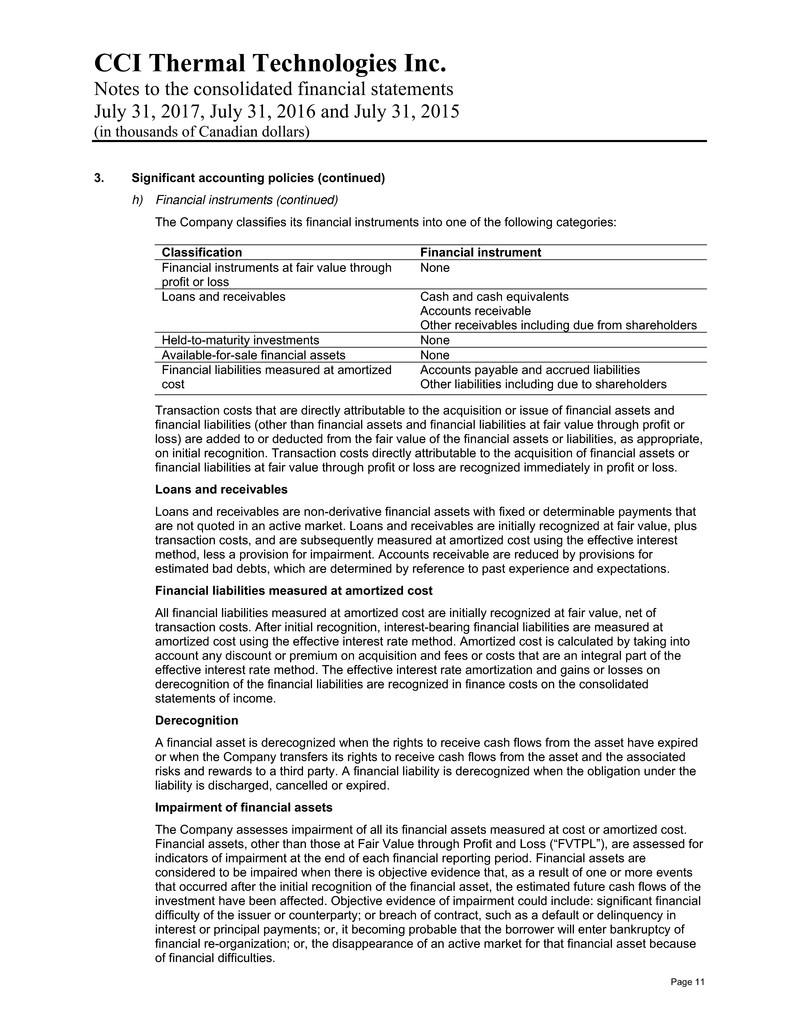
CCI Thermal Technologies Inc.
Notes to the consolidated financial statements
July 31, 2017, July 31, 2016 and July 31, 2015
(in thousands of Canadian dollars)
Page 11
3. Significant accounting policies (continued)
h) Financial instruments (continued)
The Company classifies its financial instruments into one of the following categories:
Transaction costs that are directly attributable to the acquisition or issue of financial assets and
financial liabilities (other than financial assets and financial liabilities at fair value through profit or
loss) are added to or deducted from the fair value of the financial assets or liabilities, as appropriate,
on initial recognition. Transaction costs directly attributable to the acquisition of financial assets or
financial liabilities at fair value through profit or loss are recognized immediately in profit or loss.
Loans and receivables
Loans and receivables are non-derivative financial assets with fixed or determinable payments that
are not quoted in an active market. Loans and receivables are initially recognized at fair value, plus
transaction costs, and are subsequently measured at amortized cost using the effective interest
method, less a provision for impairment. Accounts receivable are reduced by provisions for
estimated bad debts, which are determined by reference to past experience and expectations.
Financial liabilities measured at amortized cost
All financial liabilities measured at amortized cost are initially recognized at fair value, net of
transaction costs. After initial recognition, interest-bearing financial liabilities are measured at
amortized cost using the effective interest rate method. Amortized cost is calculated by taking into
account any discount or premium on acquisition and fees or costs that are an integral part of the
effective interest rate method. The effective interest rate amortization and gains or losses on
derecognition of the financial liabilities are recognized in finance costs on the consolidated
statements of income.
Derecognition
A financial asset is derecognized when the rights to receive cash flows from the asset have expired
or when the Company transfers its rights to receive cash flows from the asset and the associated
risks and rewards to a third party. A financial liability is derecognized when the obligation under the
liability is discharged, cancelled or expired.
Impairment of financial assets
The Company assesses impairment of all its financial assets measured at cost or amortized cost.
Financial assets, other than those at Fair Value through Profit and Loss (“FVTPL”), are assessed for
indicators of impairment at the end of each financial reporting period. Financial assets are
considered to be impaired when there is objective evidence that, as a result of one or more events
that occurred after the initial recognition of the financial asset, the estimated future cash flows of the
investment have been affected. Objective evidence of impairment could include: significant financial
difficulty of the issuer or counterparty; or breach of contract, such as a default or delinquency in
interest or principal payments; or, it becoming probable that the borrower will enter bankruptcy of
financial re-organization; or, the disappearance of an active market for that financial asset because
of financial difficulties.
Classification Financial instrument
Financial instruments at fair value through
profit or loss
None
Loans and receivables Cash and cash equivalents
Accounts receivable
Other receivables including due from shareholders
Held-to-maturity investments None
Available-for-sale financial assets None
Financial liabilities measured at amortized
cost
Accounts payable and accrued liabilities
Other liabilities including due to shareholders
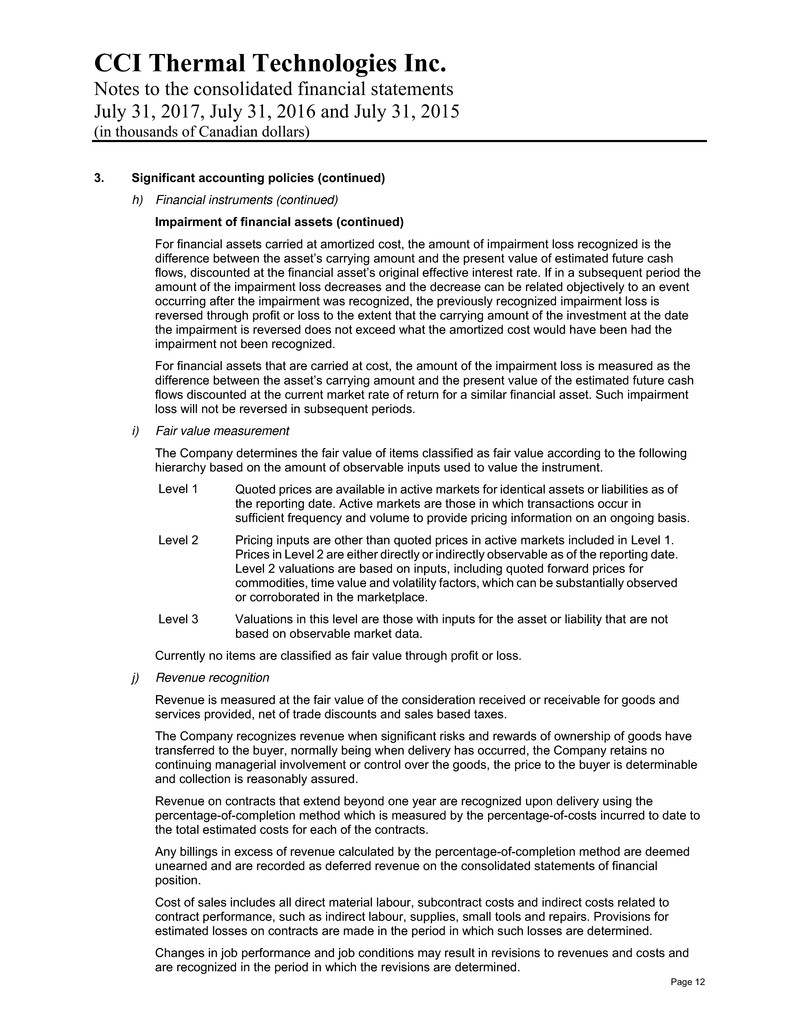
CCI Thermal Technologies Inc.
Notes to the consolidated financial statements
July 31, 2017, July 31, 2016 and July 31, 2015
(in thousands of Canadian dollars)
Page 12
3. Significant accounting policies (continued)
h) Financial instruments (continued)
Impairment of financial assets (continued)
For financial assets carried at amortized cost, the amount of impairment loss recognized is the
difference between the asset’s carrying amount and the present value of estimated future cash
flows, discounted at the financial asset’s original effective interest rate. If in a subsequent period the
amount of the impairment loss decreases and the decrease can be related objectively to an event
occurring after the impairment was recognized, the previously recognized impairment loss is
reversed through profit or loss to the extent that the carrying amount of the investment at the date
the impairment is reversed does not exceed what the amortized cost would have been had the
impairment not been recognized.
For financial assets that are carried at cost, the amount of the impairment loss is measured as the
difference between the asset’s carrying amount and the present value of the estimated future cash
flows discounted at the current market rate of return for a similar financial asset. Such impairment
loss will not be reversed in subsequent periods.
i) Fair value measurement
The Company determines the fair value of items classified as fair value according to the following
hierarchy based on the amount of observable inputs used to value the instrument.
Level 1 Quoted prices are available in active markets for identical assets or liabilities as of
the reporting date. Active markets are those in which transactions occur in
sufficient frequency and volume to provide pricing information on an ongoing basis.
Level 2 Pricing inputs are other than quoted prices in active markets included in Level 1.
Prices in Level 2 are either directly or indirectly observable as of the reporting date.
Level 2 valuations are based on inputs, including quoted forward prices for
commodities, time value and volatility factors, which can be substantially observed
or corroborated in the marketplace.
Level 3 Valuations in this level are those with inputs for the asset or liability that are not
based on observable market data.
Currently no items are classified as fair value through profit or loss.
j) Revenue recognition
Revenue is measured at the fair value of the consideration received or receivable for goods and
services provided, net of trade discounts and sales based taxes.
The Company recognizes revenue when significant risks and rewards of ownership of goods have
transferred to the buyer, normally being when delivery has occurred, the Company retains no
continuing managerial involvement or control over the goods, the price to the buyer is determinable
and collection is reasonably assured.
Revenue on contracts that extend beyond one year are recognized upon delivery using the
percentage-of-completion method which is measured by the percentage-of-costs incurred to date to
the total estimated costs for each of the contracts.
Any billings in excess of revenue calculated by the percentage-of-completion method are deemed
unearned and are recorded as deferred revenue on the consolidated statements of financial
position.
Cost of sales includes all direct material labour, subcontract costs and indirect costs related to
contract performance, such as indirect labour, supplies, small tools and repairs. Provisions for
estimated losses on contracts are made in the period in which such losses are determined.
Changes in job performance and job conditions may result in revisions to revenues and costs and
are recognized in the period in which the revisions are determined.
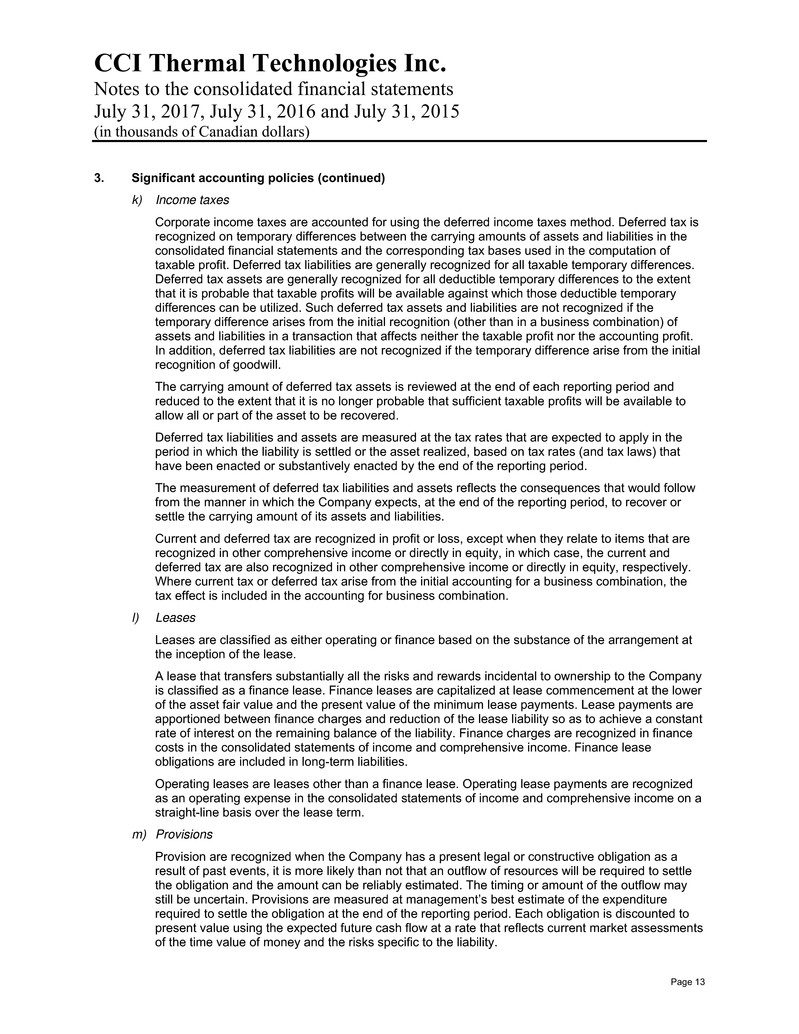
CCI Thermal Technologies Inc.
Notes to the consolidated financial statements
July 31, 2017, July 31, 2016 and July 31, 2015
(in thousands of Canadian dollars)
Page 13
3. Significant accounting policies (continued)
k) Income taxes
Corporate income taxes are accounted for using the deferred income taxes method. Deferred tax is
recognized on temporary differences between the carrying amounts of assets and liabilities in the
consolidated financial statements and the corresponding tax bases used in the computation of
taxable profit. Deferred tax liabilities are generally recognized for all taxable temporary differences.
Deferred tax assets are generally recognized for all deductible temporary differences to the extent
that it is probable that taxable profits will be available against which those deductible temporary
differences can be utilized. Such deferred tax assets and liabilities are not recognized if the
temporary difference arises from the initial recognition (other than in a business combination) of
assets and liabilities in a transaction that affects neither the taxable profit nor the accounting profit.
In addition, deferred tax liabilities are not recognized if the temporary difference arise from the initial
recognition of goodwill.
The carrying amount of deferred tax assets is reviewed at the end of each reporting period and
reduced to the extent that it is no longer probable that sufficient taxable profits will be available to
allow all or part of the asset to be recovered.
Deferred tax liabilities and assets are measured at the tax rates that are expected to apply in the
period in which the liability is settled or the asset realized, based on tax rates (and tax laws) that
have been enacted or substantively enacted by the end of the reporting period.
The measurement of deferred tax liabilities and assets reflects the consequences that would follow
from the manner in which the Company expects, at the end of the reporting period, to recover or
settle the carrying amount of its assets and liabilities.
Current and deferred tax are recognized in profit or loss, except when they relate to items that are
recognized in other comprehensive income or directly in equity, in which case, the current and
deferred tax are also recognized in other comprehensive income or directly in equity, respectively.
Where current tax or deferred tax arise from the initial accounting for a business combination, the
tax effect is included in the accounting for business combination.
l) Leases
Leases are classified as either operating or finance based on the substance of the arrangement at
the inception of the lease.
A lease that transfers substantially all the risks and rewards incidental to ownership to the Company
is classified as a finance lease. Finance leases are capitalized at lease commencement at the lower
of the asset fair value and the present value of the minimum lease payments. Lease payments are
apportioned between finance charges and reduction of the lease liability so as to achieve a constant
rate of interest on the remaining balance of the liability. Finance charges are recognized in finance
costs in the consolidated statements of income and comprehensive income. Finance lease
obligations are included in long-term liabilities.
Operating leases are leases other than a finance lease. Operating lease payments are recognized
as an operating expense in the consolidated statements of income and comprehensive income on a
straight-line basis over the lease term.
m) Provisions
Provision are recognized when the Company has a present legal or constructive obligation as a
result of past events, it is more likely than not that an outflow of resources will be required to settle
the obligation and the amount can be reliably estimated. The timing or amount of the outflow may
still be uncertain. Provisions are measured at management’s best estimate of the expenditure
required to settle the obligation at the end of the reporting period. Each obligation is discounted to
present value using the expected future cash flow at a rate that reflects current market assessments
of the time value of money and the risks specific to the liability.
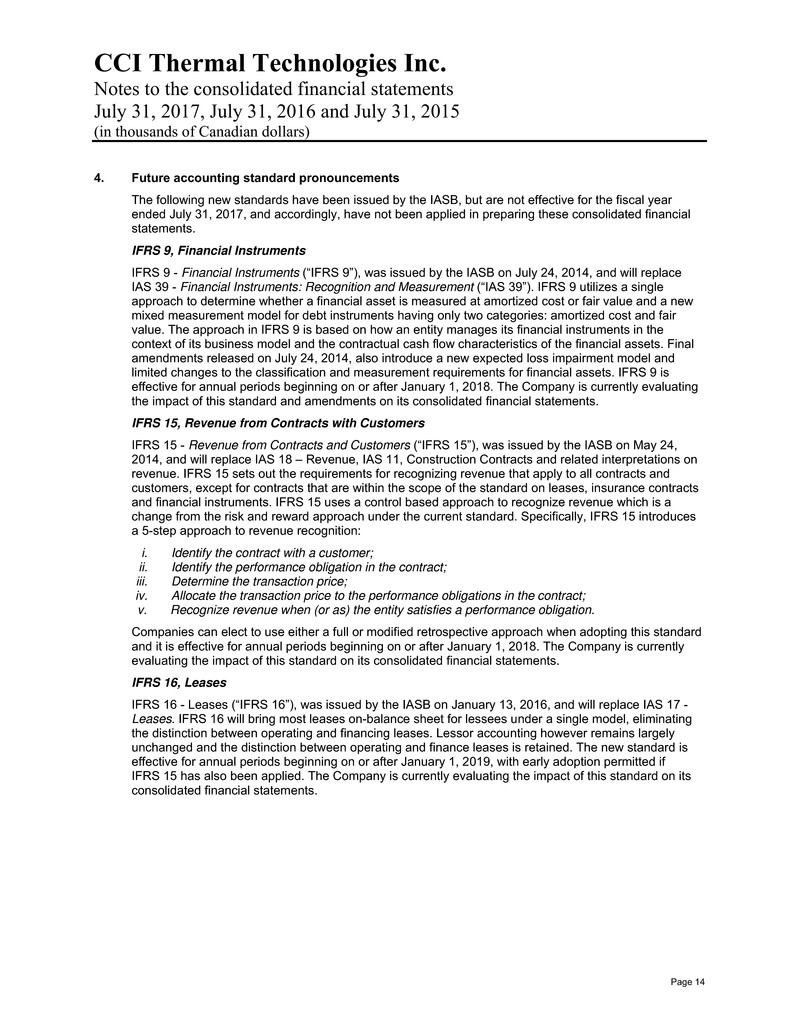
CCI Thermal Technologies Inc.
Notes to the consolidated financial statements
July 31, 2017, July 31, 2016 and July 31, 2015
(in thousands of Canadian dollars)
Page 14
4. Future accounting standard pronouncements
The following new standards have been issued by the IASB, but are not effective for the fiscal year
ended July 31, 2017, and accordingly, have not been applied in preparing these consolidated financial
statements.
IFRS 9, Financial Instruments
IFRS 9 - Financial Instruments (“IFRS 9”), was issued by the IASB on July 24, 2014, and will replace
IAS 39 - Financial Instruments: Recognition and Measurement (“IAS 39”). IFRS 9 utilizes a single
approach to determine whether a financial asset is measured at amortized cost or fair value and a new
mixed measurement model for debt instruments having only two categories: amortized cost and fair
value. The approach in IFRS 9 is based on how an entity manages its financial instruments in the
context of its business model and the contractual cash flow characteristics of the financial assets. Final
amendments released on July 24, 2014, also introduce a new expected loss impairment model and
limited changes to the classification and measurement requirements for financial assets. IFRS 9 is
effective for annual periods beginning on or after January 1, 2018. The Company is currently evaluating
the impact of this standard and amendments on its consolidated financial statements.
IFRS 15, Revenue from Contracts with Customers
IFRS 15 - Revenue from Contracts and Customers (“IFRS 15”), was issued by the IASB on May 24,
2014, and will replace IAS 18 – Revenue, IAS 11, Construction Contracts and related interpretations on
revenue. IFRS 15 sets out the requirements for recognizing revenue that apply to all contracts and
customers, except for contracts that are within the scope of the standard on leases, insurance contracts
and financial instruments. IFRS 15 uses a control based approach to recognize revenue which is a
change from the risk and reward approach under the current standard. Specifically, IFRS 15 introduces
a 5-step approach to revenue recognition:
i. Identify the contract with a customer;
ii. Identify the performance obligation in the contract;
iii. Determine the transaction price;
iv. Allocate the transaction price to the performance obligations in the contract;
v. Recognize revenue when (or as) the entity satisfies a performance obligation.
Companies can elect to use either a full or modified retrospective approach when adopting this standard
and it is effective for annual periods beginning on or after January 1, 2018. The Company is currently
evaluating the impact of this standard on its consolidated financial statements.
IFRS 16, Leases
IFRS 16 - Leases (“IFRS 16”), was issued by the IASB on January 13, 2016, and will replace IAS 17 -
Leases. IFRS 16 will bring most leases on-balance sheet for lessees under a single model, eliminating
the distinction between operating and financing leases. Lessor accounting however remains largely
unchanged and the distinction between operating and finance leases is retained. The new standard is
effective for annual periods beginning on or after January 1, 2019, with early adoption permitted if
IFRS 15 has also been applied. The Company is currently evaluating the impact of this standard on its
consolidated financial statements.

CCI Thermal Technologies Inc.
Notes to the consolidated financial statements
July 31, 2017, July 31, 2016 and July 31, 2015
(in thousands of Canadian dollars)
Page 15
5. Critical accounting judgments and key sources of estimation uncertainty
Critical judgments in applying the Company’s accounting policies
The preparation of these consolidated financial statements requires management to make estimates
and judgments that affect the reported amounts of assets and liabilities and disclosure of contingent
liabilities at the date of the consolidated financial statements and the reported amounts of revenues and
expenses during the reporting period. Accordingly, actual results could differ from these estimates and
judgments. Estimates and judgments are reviewed on an ongoing basis. Revisions to accounting
estimates are recognized in the period in which the estimate is revised and in any future periods
affected.
a) Percentage completion
Judgment used to determine percentage of completion for long-term contracts, specifically related to
completion of milestones in order to recognize revenue. Given that the expected period of contract
revenue is based on judgment, future results could be affected if management’s current assessment
of its estimated completed milestones differ from actual performance.
b) Property and equipment
As part of the capitalization process, management must estimate the expected period of benefit
over which capitalized costs should be depreciated. The considerations for estimated useful lives
include the timing of technological obsolescence and competitive pressures, as well as historical
experience and internal business plans for the projected use of related assets. Given that the
expected period of benefit is an estimate, future results could be affected if management’s current
assessment of its property and equipment’s useful lives differs from actual performance.
c) Cash-generating unit
For the purpose of assessing impairment of non-financial assets, the Company must determine its
CGUs. Assets and liabilities are grouped into CGUs at the lowest level of separately identified cash
flows. Determination of what constitutes a CGU is subject to management judgment. The asset
composition of a CGU can directly impact the recoverability of assets included within the CGU.
Management has determined that the appropriate CGUs for the Company are by geographical
location.
Key sources of estimation uncertainty
The key assumptions concerning the future and other key sources of estimating uncertainty at the
consolidated statement of financial position date that have a significant risk of causing material
adjustment to the carrying amounts of assets and liabilities within the next financial period are discussed
below:
a) Allowance for doubtful accounts receivables
At the end of each reporting period, management reviews the accounts receivable balances and
assesses recoverability based on the aging of outstanding balances, historical bad debt experience,
indicators of changes in customer credit worthiness, and changes in customer payment terms, to
identify and determine the extent of impairment, if any. Accordingly, management establishes an
allowance for estimated losses arising from non-payment and other sales adjustments, taking into
consideration individual customer credit worthiness, current economic trends as well as past
experience. If future collections differ from estimates, future earnings would be affected.
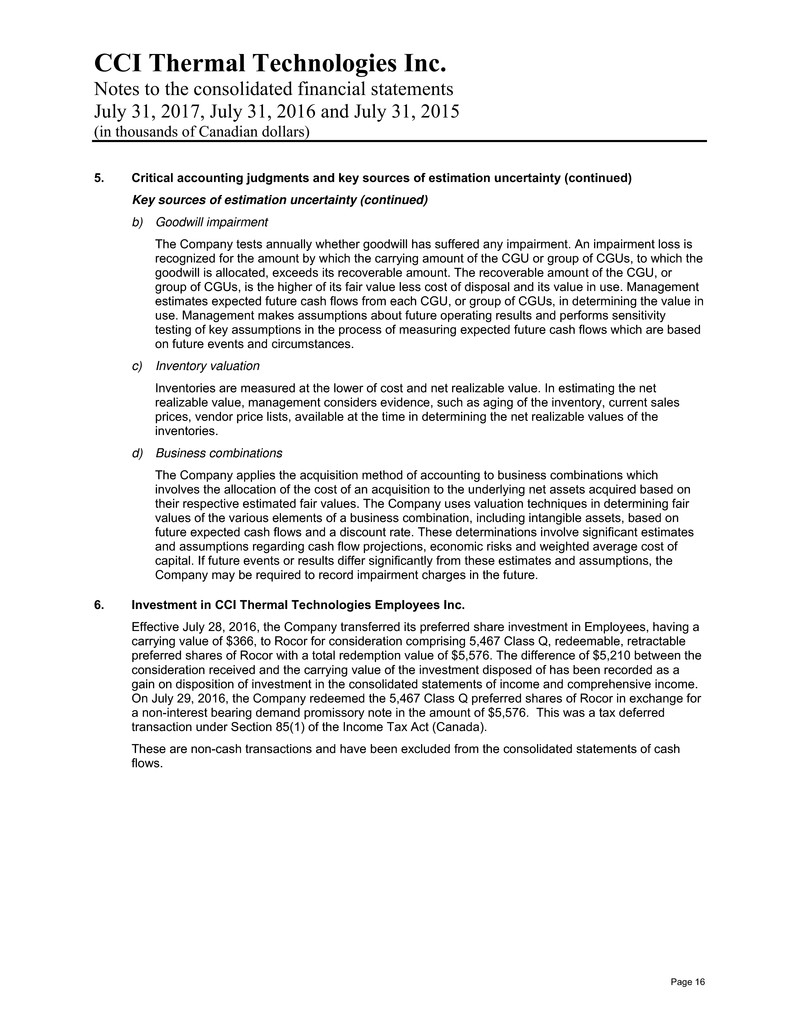
CCI Thermal Technologies Inc.
Notes to the consolidated financial statements
July 31, 2017, July 31, 2016 and July 31, 2015
(in thousands of Canadian dollars)
Page 16
5. Critical accounting judgments and key sources of estimation uncertainty (continued)
Key sources of estimation uncertainty (continued)
b) Goodwill impairment
The Company tests annually whether goodwill has suffered any impairment. An impairment loss is
recognized for the amount by which the carrying amount of the CGU or group of CGUs, to which the
goodwill is allocated, exceeds its recoverable amount. The recoverable amount of the CGU, or
group of CGUs, is the higher of its fair value less cost of disposal and its value in use. Management
estimates expected future cash flows from each CGU, or group of CGUs, in determining the value in
use. Management makes assumptions about future operating results and performs sensitivity
testing of key assumptions in the process of measuring expected future cash flows which are based
on future events and circumstances.
c) Inventory valuation
Inventories are measured at the lower of cost and net realizable value. In estimating the net
realizable value, management considers evidence, such as aging of the inventory, current sales
prices, vendor price lists, available at the time in determining the net realizable values of the
inventories.
d) Business combinations
The Company applies the acquisition method of accounting to business combinations which
involves the allocation of the cost of an acquisition to the underlying net assets acquired based on
their respective estimated fair values. The Company uses valuation techniques in determining fair
values of the various elements of a business combination, including intangible assets, based on
future expected cash flows and a discount rate. These determinations involve significant estimates
and assumptions regarding cash flow projections, economic risks and weighted average cost of
capital. If future events or results differ significantly from these estimates and assumptions, the
Company may be required to record impairment charges in the future.
6. Investment in CCI Thermal Technologies Employees Inc.
Effective July 28, 2016, the Company transferred its preferred share investment in Employees, having a
carrying value of $366, to Rocor for consideration comprising 5,467 Class Q, redeemable, retractable
preferred shares of Rocor with a total redemption value of $5,576. The difference of $5,210 between the
consideration received and the carrying value of the investment disposed of has been recorded as a
gain on disposition of investment in the consolidated statements of income and comprehensive income.
On July 29, 2016, the Company redeemed the 5,467 Class Q preferred shares of Rocor in exchange for
a non-interest bearing demand promissory note in the amount of $5,576. This was a tax deferred
transaction under Section 85(1) of the Income Tax Act (Canada).
These are non-cash transactions and have been excluded from the consolidated statements of cash
flows.
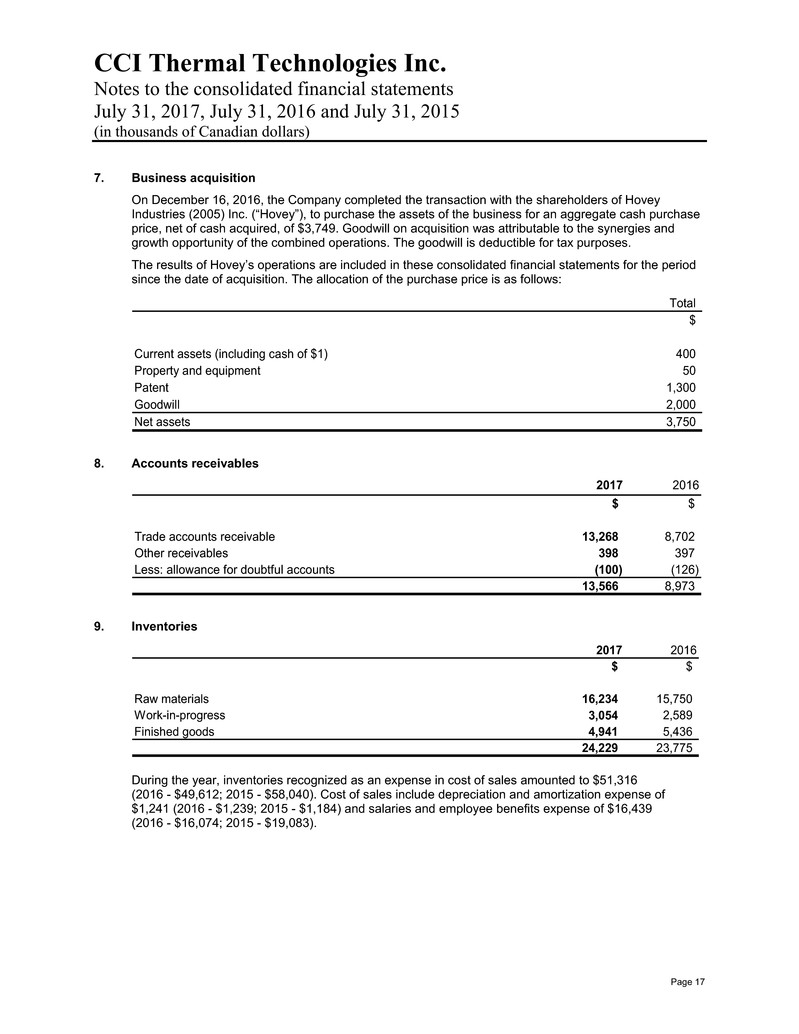
CCI Thermal Technologies Inc.
Notes to the consolidated financial statements
July 31, 2017, July 31, 2016 and July 31, 2015
(in thousands of Canadian dollars)
Page 17
7. Business acquisition
On December 16, 2016, the Company completed the transaction with the shareholders of Hovey
Industries (2005) Inc. (“Hovey”), to purchase the assets of the business for an aggregate cash purchase
price, net of cash acquired, of $3,749. Goodwill on acquisition was attributable to the synergies and
growth opportunity of the combined operations. The goodwill is deductible for tax purposes.
The results of Hovey’s operations are included in these consolidated financial statements for the period
since the date of acquisition. The allocation of the purchase price is as follows:
Total
$
Current assets (including cash of $1) 400
Property and equipment 50
Patent 1,300
Goodwill 2,000
Net assets 3,750
8. Accounts receivables
2017 2016
$ $
Trade accounts receivable 13,268 8,702
Other receivables 398 397
Less: allowance for doubtful accounts (100) (126)
13,566 8,973
9. Inventories
2017 2016
$ $
Raw materials 16,234 15,750
Work-in-progress 3,054 2,589
Finished goods 4,941 5,436
24,229 23,775
During the year, inventories recognized as an expense in cost of sales amounted to $51,316
(2016 - $49,612; 2015 - $58,040). Cost of sales include depreciation and amortization expense of
$1,241 (2016 - $1,239; 2015 - $1,184) and salaries and employee benefits expense of $16,439
(2016 - $16,074; 2015 - $19,083).
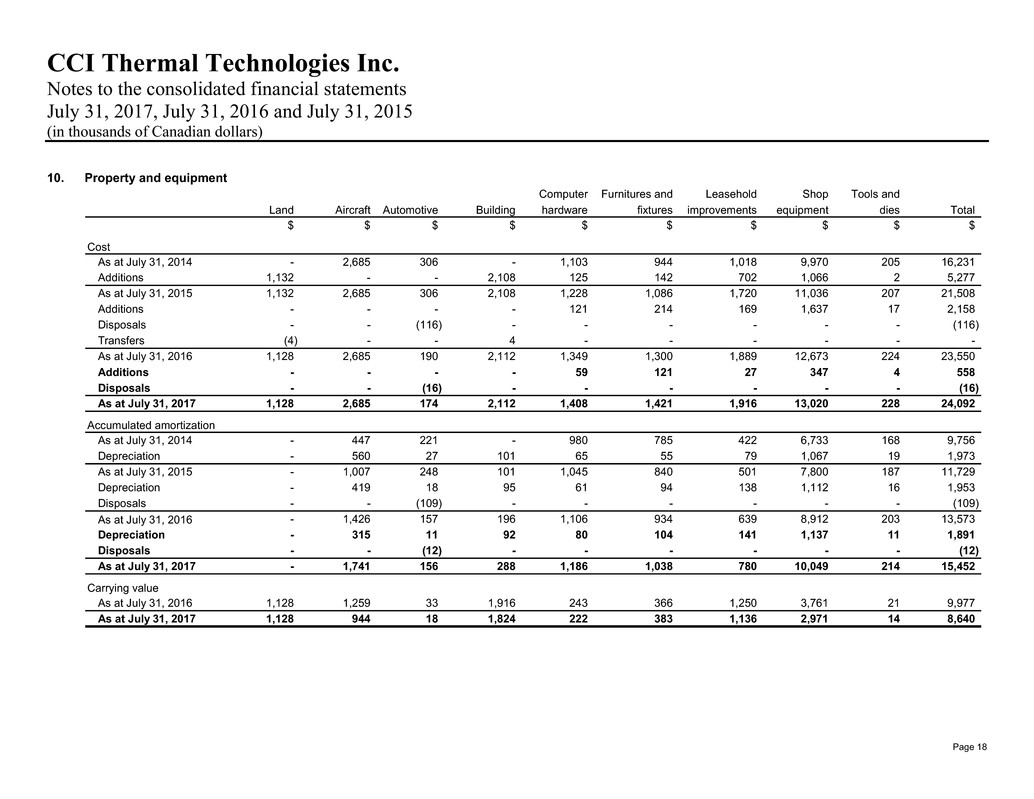
CCI Thermal Technologies Inc.
Notes to the consolidated financial statements
July 31, 2017, July 31, 2016 and July 31, 2015
(in thousands of Canadian dollars)
Page 18
10. Property and equipment
Computer Furnitures and Leasehold Shop Tools and
Land Aircraft Automotive Building hardware fixtures improvements equipment dies Total
$ $ $ $ $ $ $ $ $ $
Cost
As at July 31, 2014 - 2,685 306 - 1,103 944 1,018 9,970 205 16,231
Additions 1,132 - - 2,108 125 142 702 1,066 2 5,277
As at July 31, 2015 1,132 2,685 306 2,108 1,228 1,086 1,720 11,036 207 21,508
Additions - - - - 121 214 169 1,637 17 2,158
Disposals - - (116) - - - - - - (116)
Transfers (4) - - 4 - - - - - -
As at July 31, 2016 1,128 2,685 190 2,112 1,349 1,300 1,889 12,673 224 23,550
Additions - - - - 59 121 27 347 4 558
Disposals - - (16) - - - - - - (16)
As at July 31, 2017 1,128 2,685 174 2,112 1,408 1,421 1,916 13,020 228 24,092
Accumulated amortization
As at July 31, 2014 - 447 221 - 980 785 422 6,733 168 9,756
Depreciation - 560 27 101 65 55 79 1,067 19 1,973
As at July 31, 2015 - 1,007 248 101 1,045 840 501 7,800 187 11,729
Depreciation - 419 18 95 61 94 138 1,112 16 1,953
Disposals - - (109) - - - - - - (109)
As at July 31, 2016 - 1,426 157 196 1,106 934 639 8,912 203 13,573
Depreciation - 315 11 92 80 104 141 1,137 11 1,891
Disposals - - (12) - - - - - - (12)
As at July 31, 2017 - 1,741 156 288 1,186 1,038 780 10,049 214 15,452
Carrying value
As at July 31, 2016 1,128 1,259 33 1,916 243 366 1,250 3,761 21 9,977
As at July 31, 2017 1,128 944 18 1,824 222 383 1,136 2,971 14 8,640

CCI Thermal Technologies Inc.
Notes to the consolidated financial statements
July 31, 2017, July 31, 2016 and July 31, 2015
(in thousands of Canadian dollars)
Page 19
11. Intangible assets
Other
Caloritech 3L Filters Ruffneck Fastrax Heat pipe
Explosion
proof bed 3L Filters Ruffneck Flo-Dri Hovey Fastrax
Computer
software Total
$ $ $ $ $ $ $ $ $ $ $ $ $
Cost
As at July 31, 2014 6,156 100 2,000 5,216 101 2,170 1,270 4,600 134 - 689 1,200 23,636
Additions - - - - - - - - - - - 48 48
As at July 31, 2015 6,156 100 2,000 5,216 101 2,170 1,270 4,600 134 - 689 1,248 23,684
Additions - - - 325 - - - - - - - 107 432
As at July 31, 2016 6,156 100 2,000 5,541 101 2,170 1,270 4,600 134 - 689 1,355 24,116
Additions - - - - - - - - - 1,300 - 17 1,317
As at July 31, 2017 6,156 100 2,000 5,541 101 2,170 1,270 4,600 134 1,300 689 1,372 25,433
Accumulated amortization
As at July 31, 2014 5,322 72 1,882 551 101 2,170 878 3,642 102 - 109 1,020 15,849
Amortization 400 11 84 348 - - 127 460 13 - 69 62 1,574
As at July 31, 2015 5,722 83 1,966 899 101 2,170 1,005 4,102 115 - 178 1,082 17,423
Amortization 401 11 34 359 - - 127 460 13 - 69 75 1,549
As at July 31, 2016 6,123 94 2,000 1,258 101 2,170 1,132 4,562 128 - 247 1,157 18,972
Amortization 33 6 - 375 - - 127 38 6 76 69 60 790
As at July 31, 2017 6,156 100 2,000 1,633 101 2,170 1,259 4,600 134 76 316 1,217 19,762
Carrying value
As at July 31, 2016 33 6 - 4,283 - - 138 38 6 - 442 198 5,144
As at July 31, 2017 - - - 3,908 - - 11 - - 1,224 373 155 5,671
Limited life trademarksLimited life patents
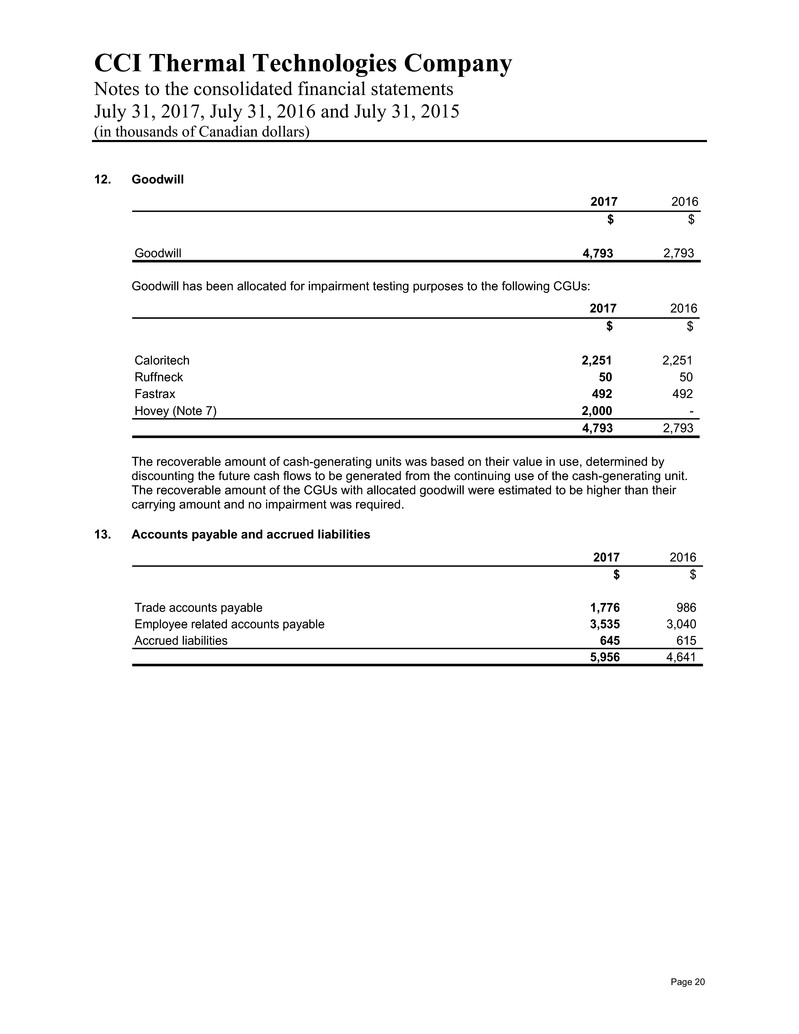
CCI Thermal Technologies Company
Notes to the consolidated financial statements
July 31, 2017, July 31, 2016 and July 31, 2015
(in thousands of Canadian dollars)
Page 20
12. Goodwill
2017 2016
$ $
Goodwill 4,793 2,793
Goodwill has been allocated for impairment testing purposes to the following CGUs:
2017 2016
$ $
Caloritech 2,251 2,251
Ruffneck 50 50
Fastrax 492 492
Hovey (Note 7) 2,000 -
4,793 2,793
The recoverable amount of cash-generating units was based on their value in use, determined by
discounting the future cash flows to be generated from the continuing use of the cash-generating unit.
The recoverable amount of the CGUs with allocated goodwill were estimated to be higher than their
carrying amount and no impairment was required.
13. Accounts payable and accrued liabilities
2017 2016
$ $
Trade accounts payable 1,776 986
Employee related accounts payable 3,535 3,040
Accrued liabilities 645 615
5,956 4,641
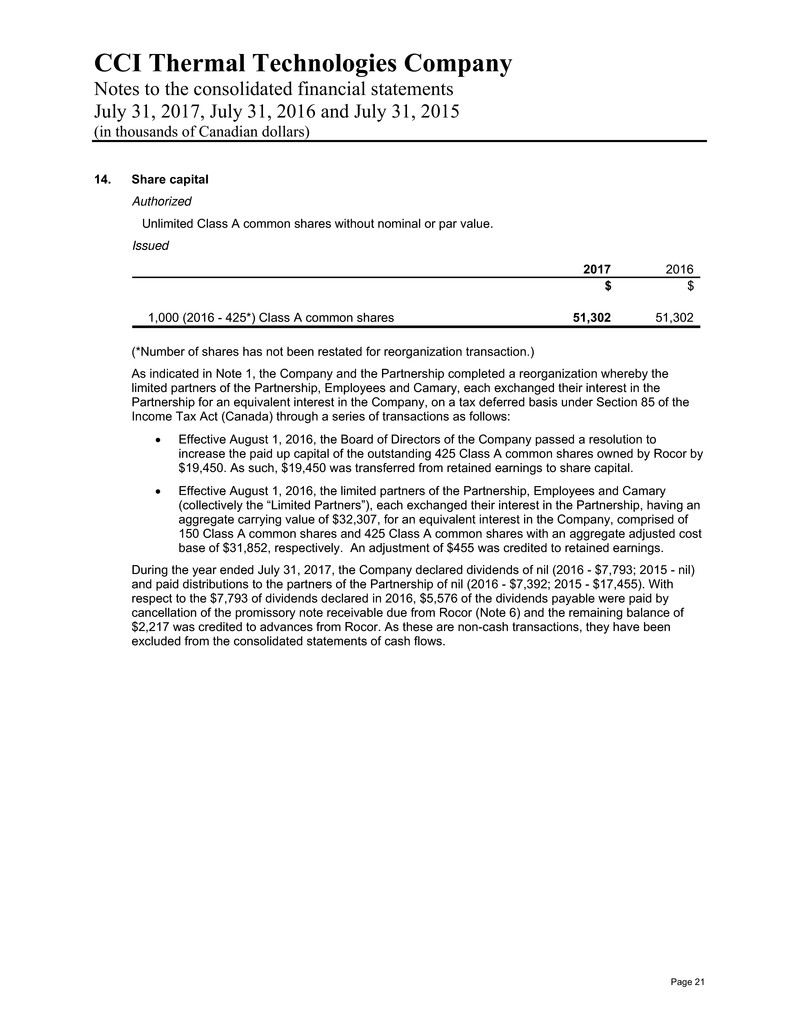
CCI Thermal Technologies Company
Notes to the consolidated financial statements
July 31, 2017, July 31, 2016 and July 31, 2015
(in thousands of Canadian dollars)
Page 21
14. Share capital
Authorized
Unlimited Class A common shares without nominal or par value.
Issued
2017 2016
$ $
1,000 (2016 - 425*) Class A common shares 51,302 51,302
(*Number of shares has not been restated for reorganization transaction.)
As indicated in Note 1, the Company and the Partnership completed a reorganization whereby the
limited partners of the Partnership, Employees and Camary, each exchanged their interest in the
Partnership for an equivalent interest in the Company, on a tax deferred basis under Section 85 of the
Income Tax Act (Canada) through a series of transactions as follows:
Effective August 1, 2016, the Board of Directors of the Company passed a resolution to
increase the paid up capital of the outstanding 425 Class A common shares owned by Rocor by
$19,450. As such, $19,450 was transferred from retained earnings to share capital.
Effective August 1, 2016, the limited partners of the Partnership, Employees and Camary
(collectively the “Limited Partners”), each exchanged their interest in the Partnership, having an
aggregate carrying value of $32,307, for an equivalent interest in the Company, comprised of
150 Class A common shares and 425 Class A common shares with an aggregate adjusted cost
base of $31,852, respectively. An adjustment of $455 was credited to retained earnings.
During the year ended July 31, 2017, the Company declared dividends of nil (2016 - $7,793; 2015 - nil)
and paid distributions to the partners of the Partnership of nil (2016 - $7,392; 2015 - $17,455). With
respect to the $7,793 of dividends declared in 2016, $5,576 of the dividends payable were paid by
cancellation of the promissory note receivable due from Rocor (Note 6) and the remaining balance of
$2,217 was credited to advances from Rocor. As these are non-cash transactions, they have been
excluded from the consolidated statements of cash flows.
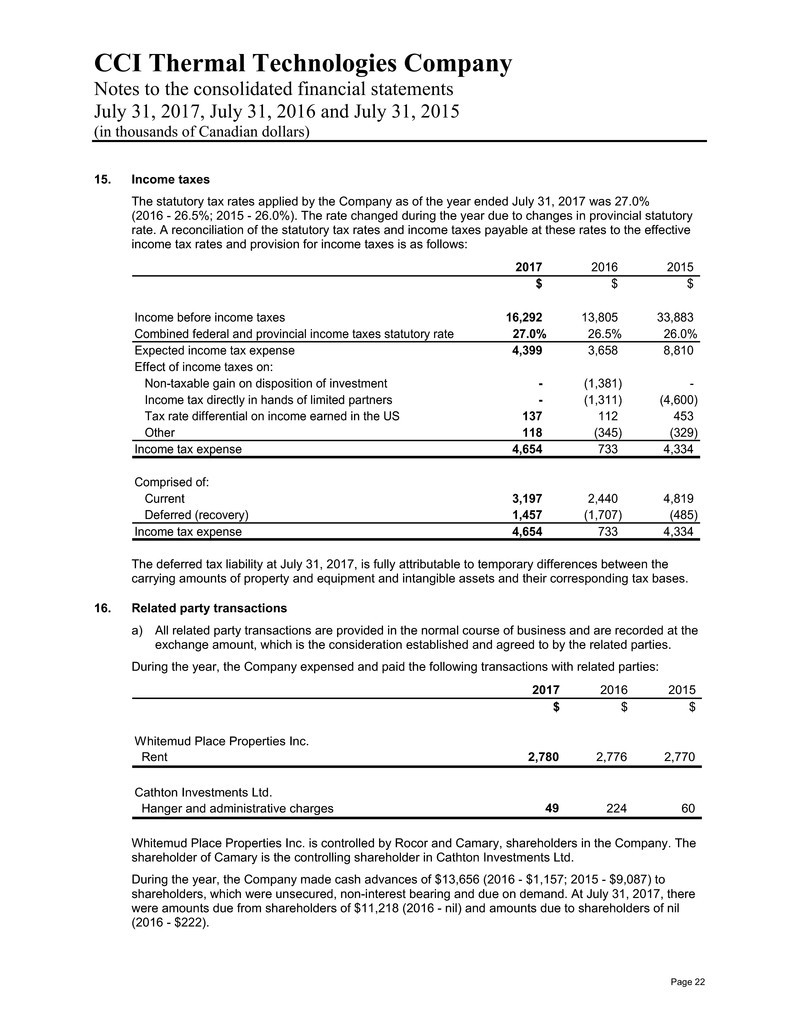
CCI Thermal Technologies Company
Notes to the consolidated financial statements
July 31, 2017, July 31, 2016 and July 31, 2015
(in thousands of Canadian dollars)
Page 22
15. Income taxes
The statutory tax rates applied by the Company as of the year ended July 31, 2017 was 27.0%
(2016 - 26.5%; 2015 - 26.0%). The rate changed during the year due to changes in provincial statutory
rate. A reconciliation of the statutory tax rates and income taxes payable at these rates to the effective
income tax rates and provision for income taxes is as follows:
2017 2016 2015
$ $ $
Income before income taxes 16,292 13,805 33,883
Combined federal and provincial income taxes statutory rate 27.0% 26.5% 26.0%
Expected income tax expense 4,399 3,658 8,810
Effect of income taxes on:
Non-taxable gain on disposition of investment - (1,381) -
Income tax directly in hands of limited partners - (1,311) (4,600)
Tax rate differential on income earned in the US 137 112 453
Other 118 (345) (329)
Income tax expense 4,654 733 4,334
Comprised of:
Current 3,197 2,440 4,819
Deferred (recovery) 1,457 (1,707) (485)
Income tax expense 4,654 733 4,334
The deferred tax liability at July 31, 2017, is fully attributable to temporary differences between the
carrying amounts of property and equipment and intangible assets and their corresponding tax bases.
16. Related party transactions
a) All related party transactions are provided in the normal course of business and are recorded at the
exchange amount, which is the consideration established and agreed to by the related parties.
During the year, the Company expensed and paid the following transactions with related parties:
2017 2016 2015
$ $ $
Whitemud Place Properties Inc.
Rent 2,780 2,776 2,770
Cathton Investments Ltd.
Hanger and administrative charges 49 224 60
Whitemud Place Properties Inc. is controlled by Rocor and Camary, shareholders in the Company. The
shareholder of Camary is the controlling shareholder in Cathton Investments Ltd.
During the year, the Company made cash advances of $13,656 (2016 - $1,157; 2015 - $9,087) to
shareholders, which were unsecured, non-interest bearing and due on demand. At July 31, 2017, there
were amounts due from shareholders of $11,218 (2016 - nil) and amounts due to shareholders of nil
(2016 - $222).

CCI Thermal Technologies Company
Notes to the consolidated financial statements
July 31, 2017, July 31, 2016 and July 31, 2015
(in thousands of Canadian dollars)
Page 23
16. Related party transactions (continued)
b) The remuneration of directors and other members of key management personnel during the year
was as follows:
2017 2016 2015
$ $ $
Salary and short-term benefits 1,347 1,195 1,359
17. Financial instruments
Financial instruments consist of recorded amounts of cash and cash equivalents, accounts receivable,
and other like-amounts that result in future cash receipts as well as accounts payable and accrued
liabilities and other like-amounts that will result in future cash outlays.
Fair value of financial instruments
The fair value of financial instruments is the amount that would be agreed to in arm’s length transaction
between knowledgeable, willing parties who are under no obligation to act. Fair value can be determined
by reference to prices in active markets to which the Company has access. In the absence of active
markets, the Company determines fair value based on market or by reference to other similar products.
The carrying values of cash and cash equivalents, accounts receivables and accounts payables and
accrued liabilities approximate their estimated fair value due to their short terms to maturity. The fair
values of the amounts due from and to shareholders cannot be estimated with sufficient reliability given
that the balances originated in transactions with related parties, have no fixed repayment dates and no
market exists for financial instruments of this type.
Financial risk management
The significant financial risks to which the Company is exposed are credit risk, foreign exchange risk
and liquidity risk. Management reviews these risks on an ongoing basis to ensure that the risks are
appropriately managed. The Company had no derivatives outstanding at July 31, 2017 or July 31, 2016.
Credit risk
Credit risk is the risk that one party to a financial instrument will cause a financial loss for the other party
by failing to discharge an obligation. The Company is exposed to credit risk in the event of non-
performance by counterparties in connection with its accounts receivable. The Company does not obtain
collateral or other security to support the accounts receivable subject to credit risk but mitigates this risk
by dealing only with what management believes to be financially sound counterparties and, accordingly,
does not anticipate significant loss for non-performance.
The Company’s exposure to credit risk in respect of its cash and cash equivalents is not significant as
the balance is highly liquid, subject to an insignificant risk of changes in value and held with major
Canadian chartered banks that management assesses to be financially sound.
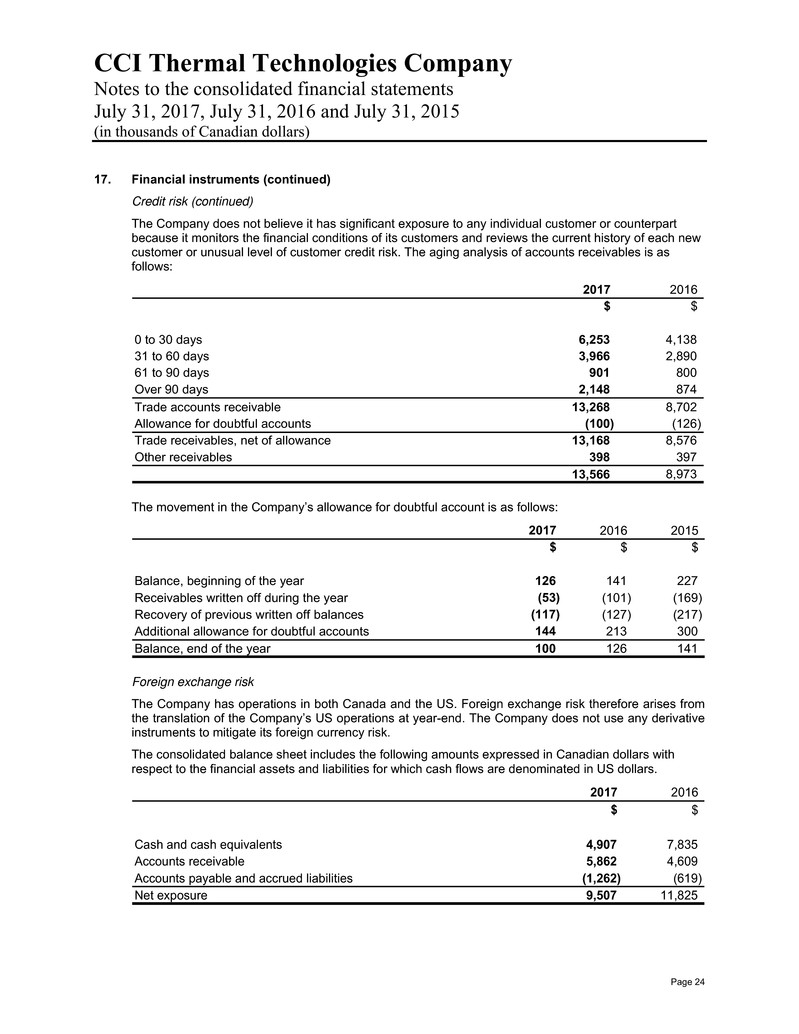
CCI Thermal Technologies Company
Notes to the consolidated financial statements
July 31, 2017, July 31, 2016 and July 31, 2015
(in thousands of Canadian dollars)
Page 24
17. Financial instruments (continued)
Credit risk (continued)
The Company does not believe it has significant exposure to any individual customer or counterpart
because it monitors the financial conditions of its customers and reviews the current history of each new
customer or unusual level of customer credit risk. The aging analysis of accounts receivables is as
follows:
2017 2016
$ $
0 to 30 days 6,253 4,138
31 to 60 days 3,966 2,890
61 to 90 days 901 800
Over 90 days 2,148 874
Trade accounts receivable 13,268 8,702
Allowance for doubtful accounts (100) (126)
Trade receivables, net of allowance 13,168 8,576
Other receivables 398 397
13,566 8,973
The movement in the Company’s allowance for doubtful account is as follows:
2017 2016 2015
$ $ $
Balance, beginning of the year 126 141 227
Receivables written off during the year (53) (101) (169)
Recovery of previous written off balances (117) (127) (217)
Additional allowance for doubtful accounts 144 213 300
Balance, end of the year 100 126 141
Foreign exchange risk
The Company has operations in both Canada and the US. Foreign exchange risk therefore arises from
the translation of the Company’s US operations at year-end. The Company does not use any derivative
instruments to mitigate its foreign currency risk.
The consolidated balance sheet includes the following amounts expressed in Canadian dollars with
respect to the financial assets and liabilities for which cash flows are denominated in US dollars.
2017 2016
$ $
Cash and cash equivalents 4,907 7,835
Accounts receivable 5,862 4,609
Accounts payable and accrued liabilities (1,262) (619)
Net exposure 9,507 11,825

CCI Thermal Technologies Company
Notes to the consolidated financial statements
July 31, 2017, July 31, 2016 and July 31, 2015
(in thousands of Canadian dollars)
Page 25
17. Financial instruments (continued)
Liquidity risk
The Company’s objective is to have sufficient liquidity to meet its liabilities when due. The Company
monitors its cash balances and cash flows generated from operations to meet its requirements. As at
July 31, 2017 and July 31, 2016, significant liabilities of the Company include accounts payable and
accrued liabilities.
The Company has the following financial liabilities as at July 31, 2017:
Due within
one year
Due between
one and five
years
Due after
five years Total
$ $ $ $
Accounts payable and accrued liabilities 5,956 - - 5,956
The Company has the following financial liabilities as at July 31, 2016:
Due within
one year
Due between
one and five
years
Due after
five years Total
$ $ $ $
Accounts payable and accrued liabilities 4,641 - - 4,641
Dividends payable 7,793 - - 7,793
12,434 - - 12,434
18. Commitments
The Company has entered into four premises lease agreements with Whitemud Place Properties Inc.
expiring August 31, 2024 (Edmonton), December 31, 2023 (Nisku), July 1, 2018 (Oakville), and July 31,
2022 (Orillia). Whitemud Place Properties Inc. is a related party (Note 16). The Company also has a
premise lease agreement in Houston expiring June 30, 2018.
Future minimum lease payments in the next five years are as follows:
Whitemud Place Arm's
Properties Inc. length Total
$ $ $
Not later than 1 year 2,764 71 2,835
Later than 1 year and not later than 5 years 7,593 - 7,593
Later than 5 years 2,725 - 2,725
19. Contingent liabilities
Performance security guarantees of $685 (2016 - $867) have been provided on certain outstanding
sales contracts. These guarantees have been issued by CIBC, and in order to facilitate these
transactions, ATB Financial has provided a guarantee of $400 (2016 - $400) to CIBC.
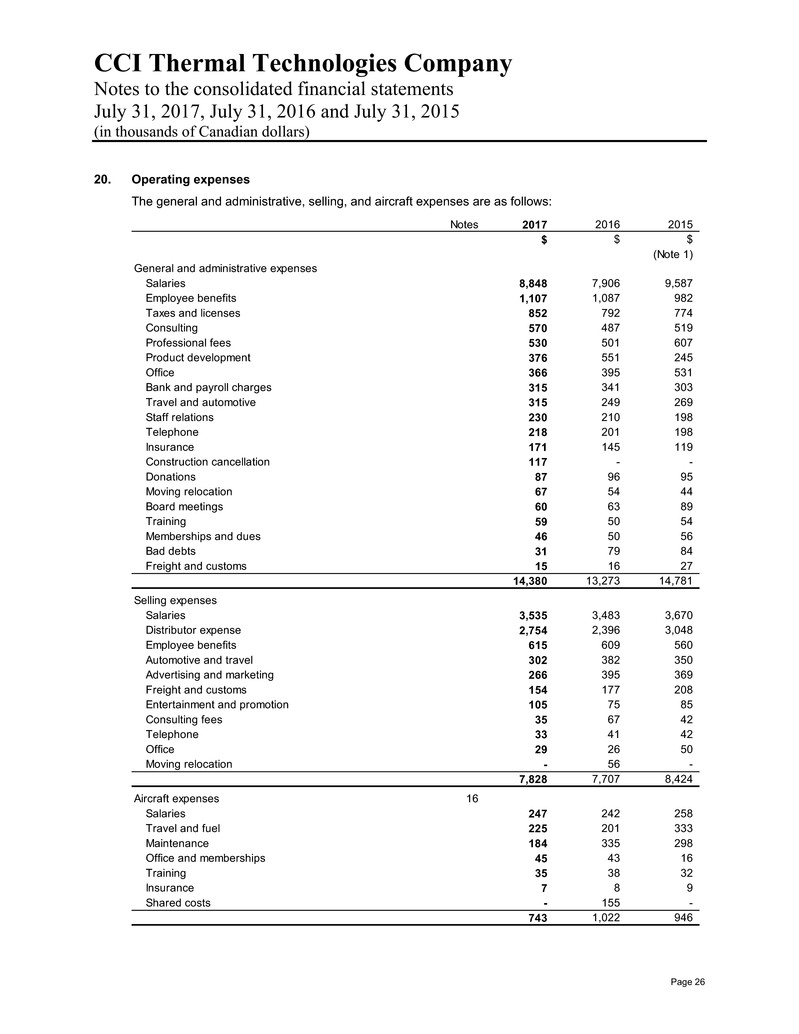
CCI Thermal Technologies Company
Notes to the consolidated financial statements
July 31, 2017, July 31, 2016 and July 31, 2015
(in thousands of Canadian dollars)
Page 26
20. Operating expenses
The general and administrative, selling, and aircraft expenses are as follows:
Notes 2017 2016 2015
$ $ $
(Note 1)
General and administrative expenses
Salaries 8,848 7,906 9,587
Employee benefits 1,107 1,087 982
Taxes and licenses 852 792 774
Consulting 570 487 519
Professional fees 530 501 607
Product development 376 551 245
Office 366 395 531
Bank and payroll charges 315 341 303
Travel and automotive 315 249 269
Staff relations 230 210 198
Telephone 218 201 198
Insurance 171 145 119
Construction cancellation 117 - -
Donations 87 96 95
Moving relocation 67 54 44
Board meetings 60 63 89
Training 59 50 54
Memberships and dues 46 50 56
Bad debts 31 79 84
Freight and customs 15 16 27
14,380 13,273 14,781
Selling expenses
Salaries 3,535 3,483 3,670
Distributor expense 2,754 2,396 3,048
Employee benefits 615 609 560
Automotive and travel 302 382 350
Advertising and marketing 266 395 369
Freight and customs 154 177 208
Entertainment and promotion 105 75 85
Consulting fees 35 67 42
Telephone 33 41 42
Office 29 26 50
Moving relocation - 56 -
7,828 7,707 8,424
Aircraft expenses 16
Salaries 247 242 258
Travel and fuel 225 201 333
Maintenance 184 335 298
Office and memberships 45 43 16
Training 35 38 32
Insurance 7 8 9
Shared costs - 155 -
743 1,022 946
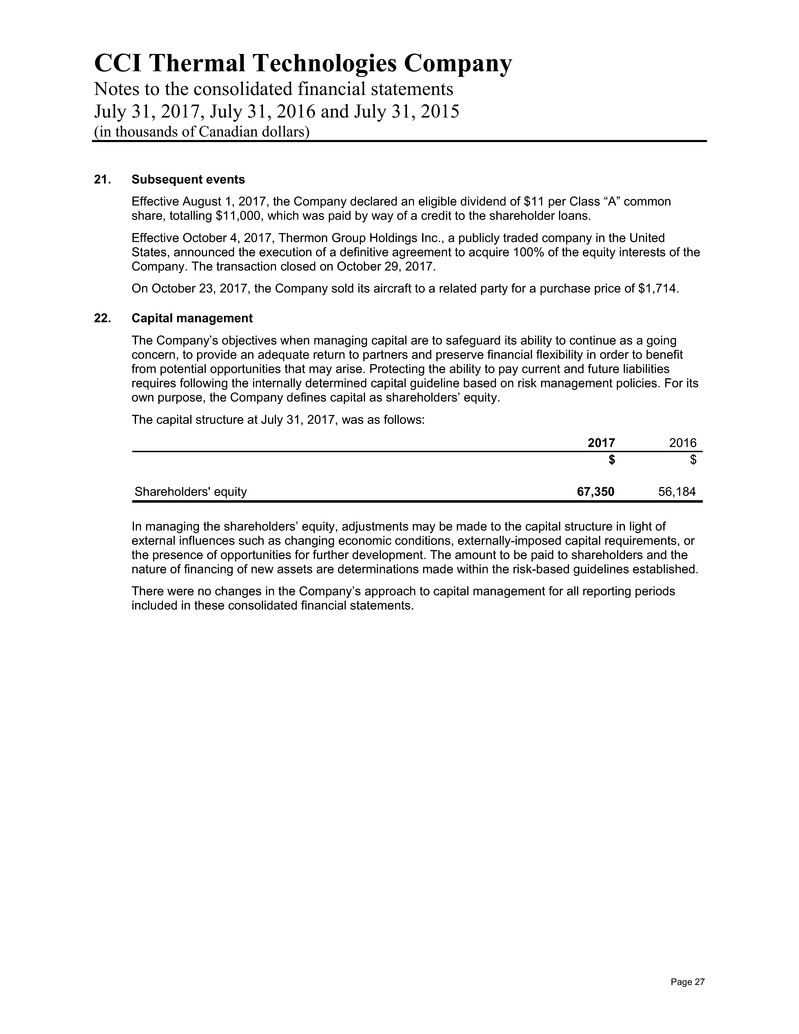
CCI Thermal Technologies Company
Notes to the consolidated financial statements
July 31, 2017, July 31, 2016 and July 31, 2015
(in thousands of Canadian dollars)
Page 27
21. Subsequent events
Effective August 1, 2017, the Company declared an eligible dividend of $11 per Class “A” common
share, totalling $11,000, which was paid by way of a credit to the shareholder loans.
Effective October 4, 2017, Thermon Group Holdings Inc., a publicly traded company in the United
States, announced the execution of a definitive agreement to acquire 100% of the equity interests of the
Company. The transaction closed on October 29, 2017.
On October 23, 2017, the Company sold its aircraft to a related party for a purchase price of $1,714.
22. Capital management
The Company’s objectives when managing capital are to safeguard its ability to continue as a going
concern, to provide an adequate return to partners and preserve financial flexibility in order to benefit
from potential opportunities that may arise. Protecting the ability to pay current and future liabilities
requires following the internally determined capital guideline based on risk management policies. For its
own purpose, the Company defines capital as shareholders’ equity.
The capital structure at July 31, 2017, was as follows:
2017 2016
$ $
Shareholders' equity 67,350 56,184
In managing the shareholders’ equity, adjustments may be made to the capital structure in light of
external influences such as changing economic conditions, externally-imposed capital requirements, or
the presence of opportunities for further development. The amount to be paid to shareholders and the
nature of financing of new assets are determinations made within the risk-based guidelines established.
There were no changes in the Company’s approach to capital management for all reporting periods
included in these consolidated financial statements.
